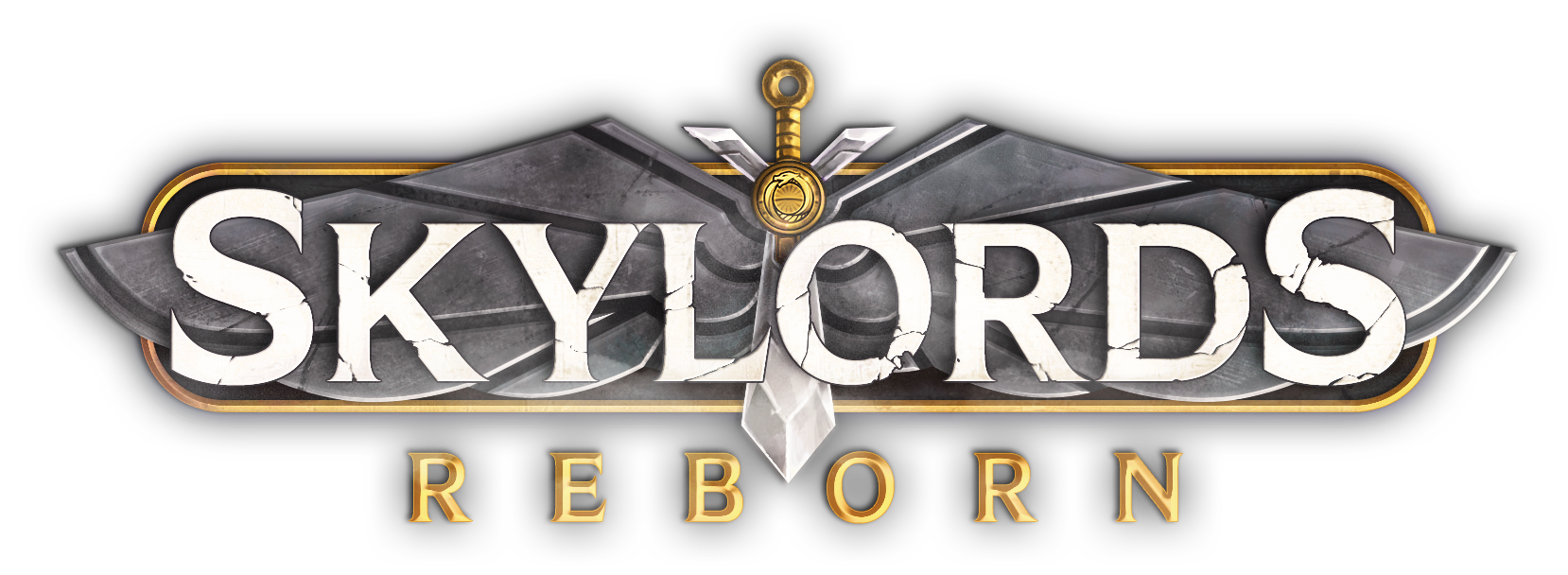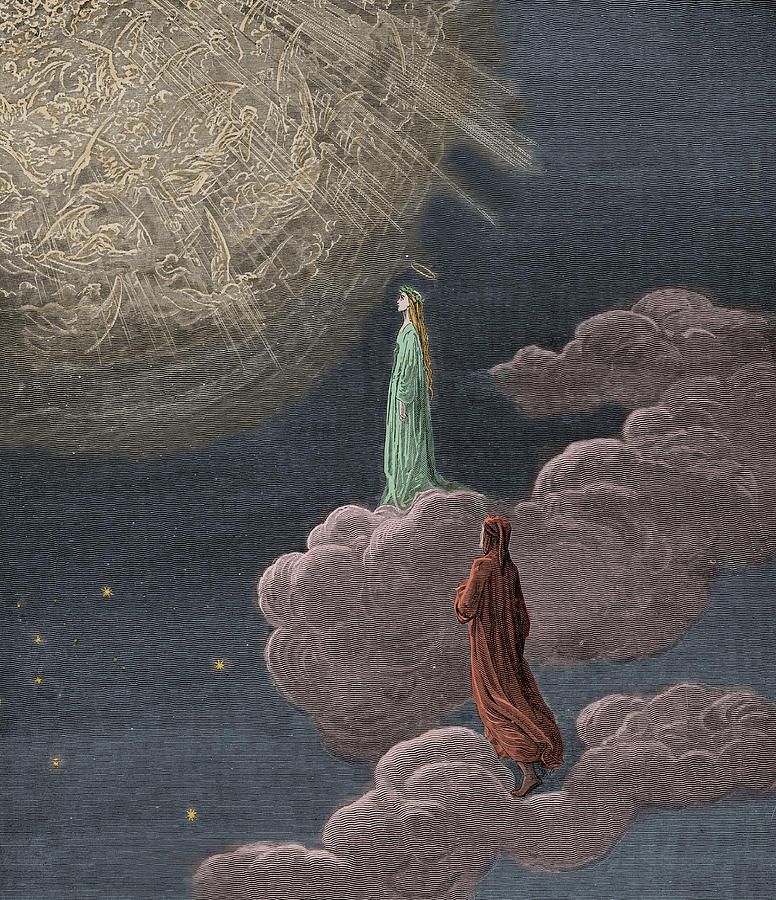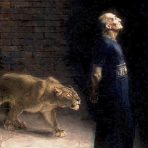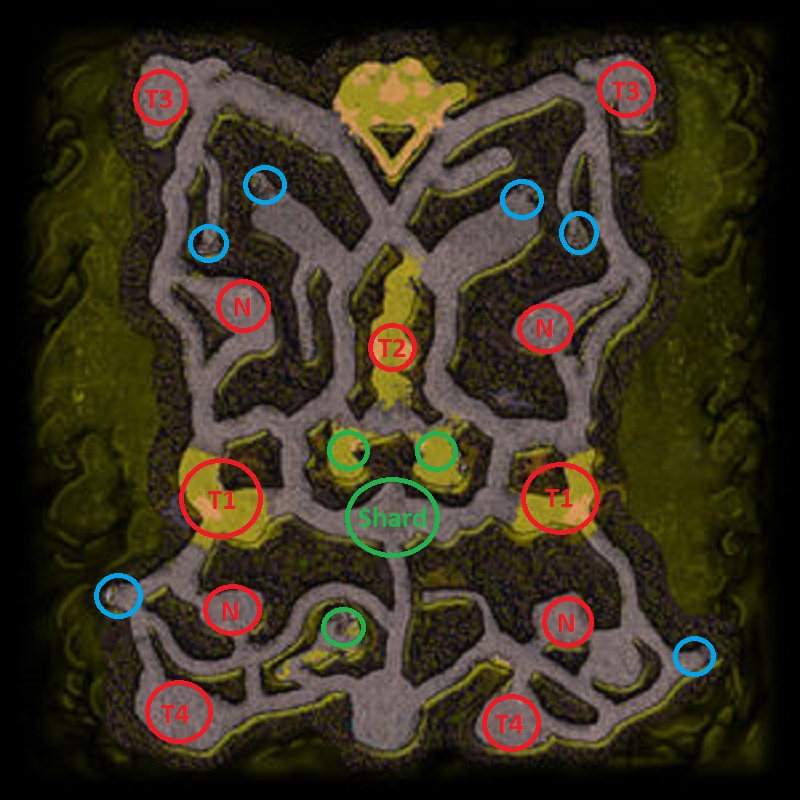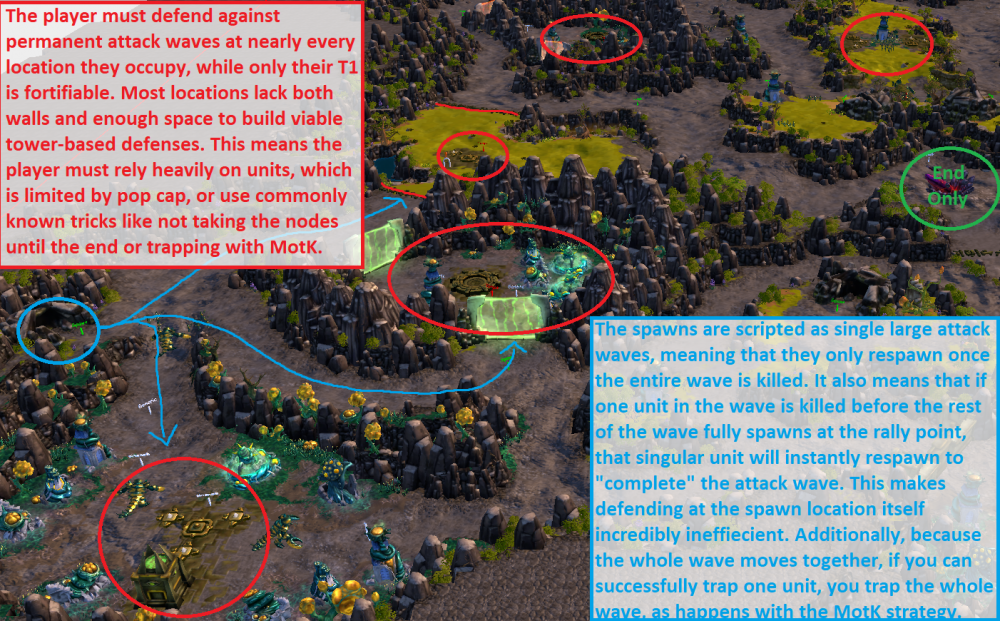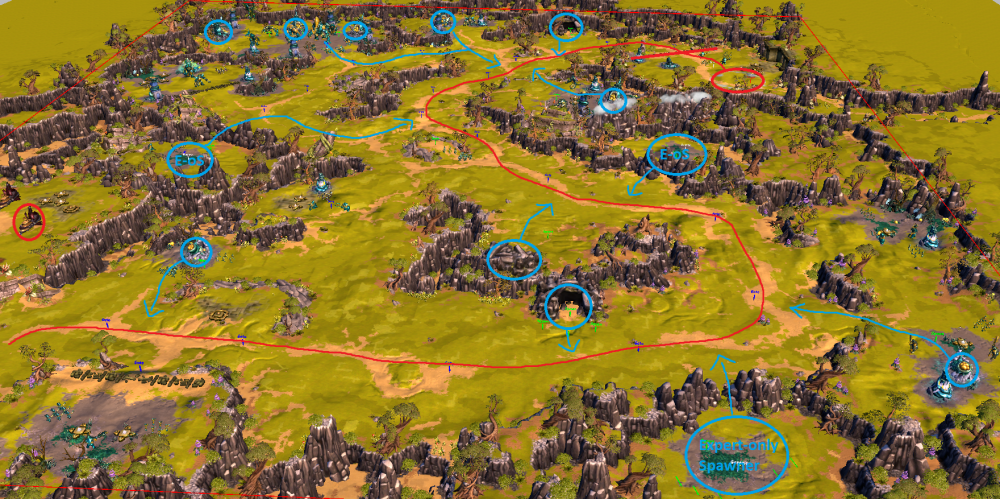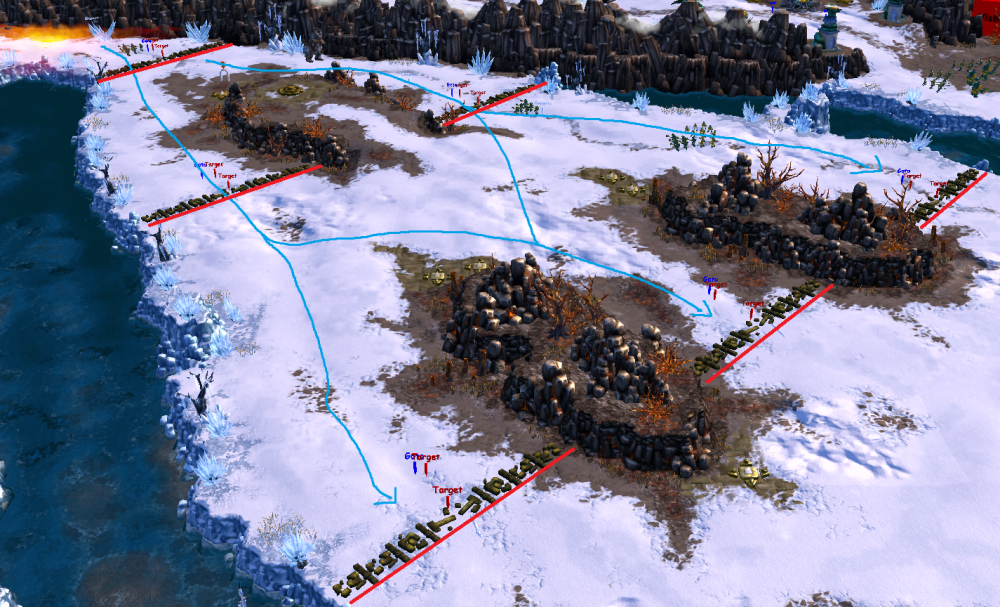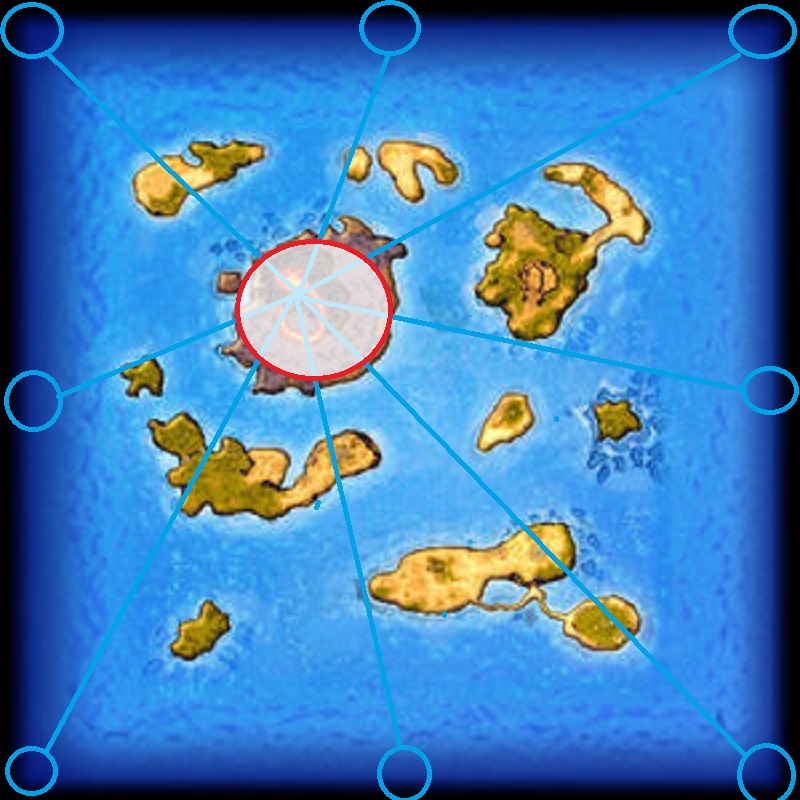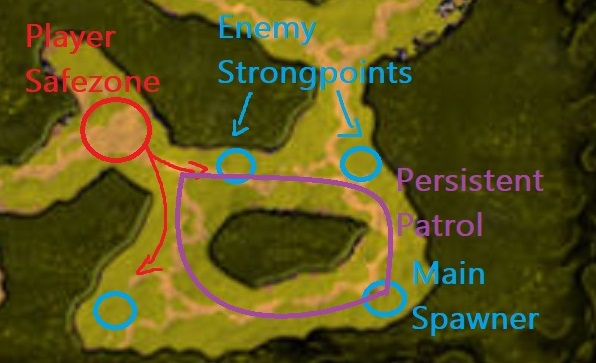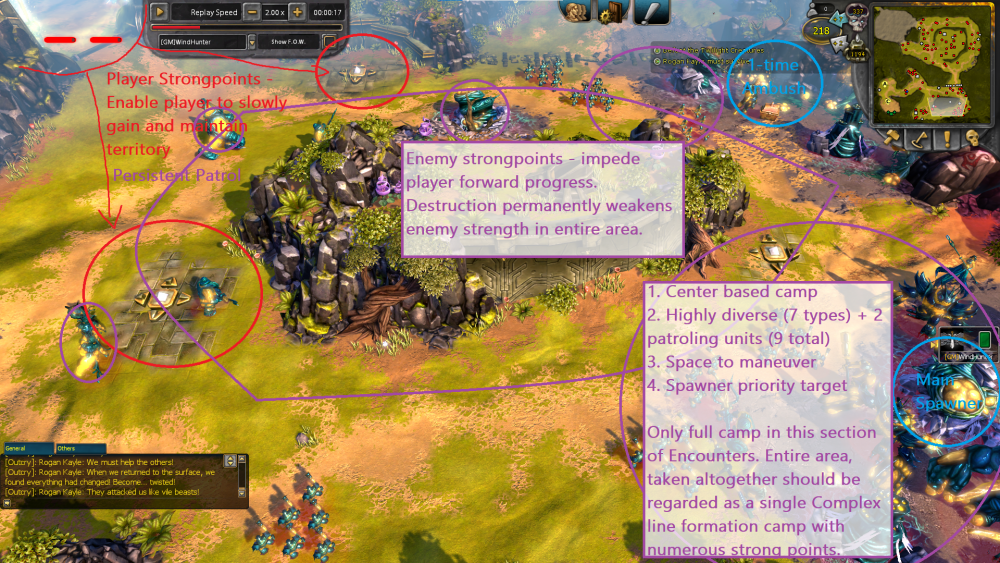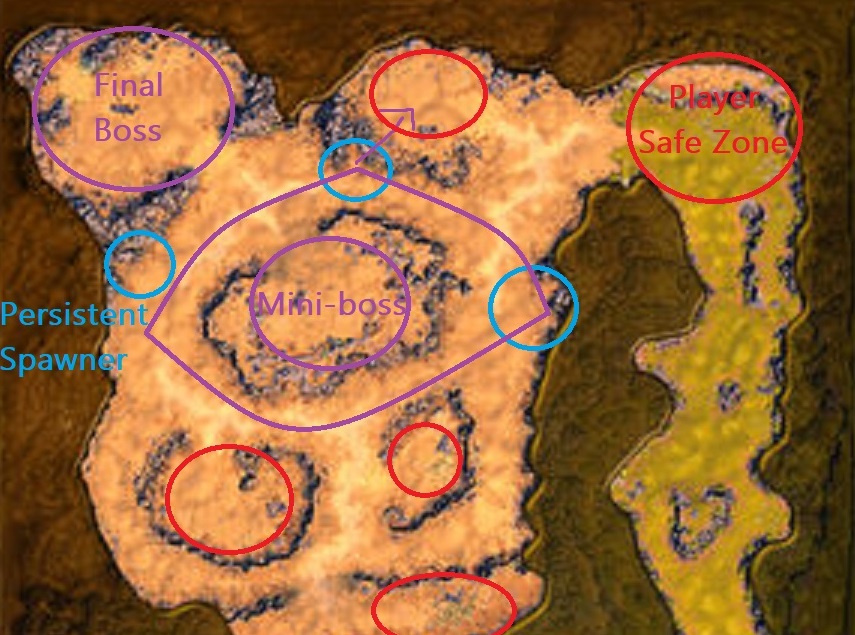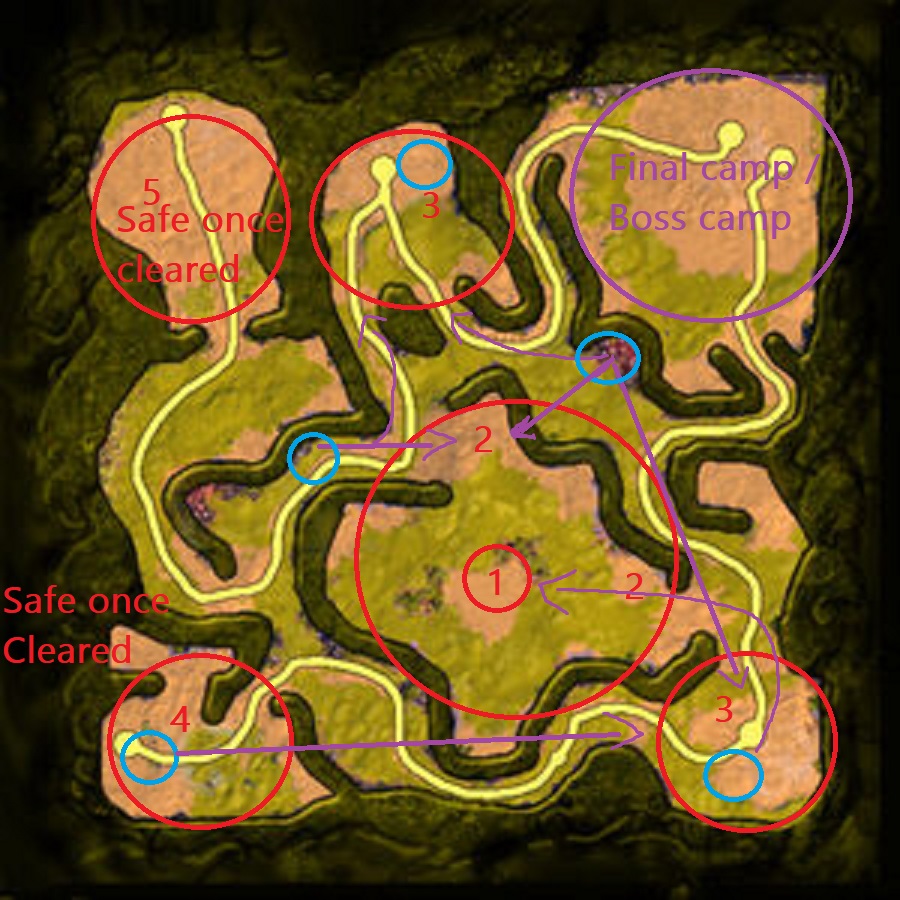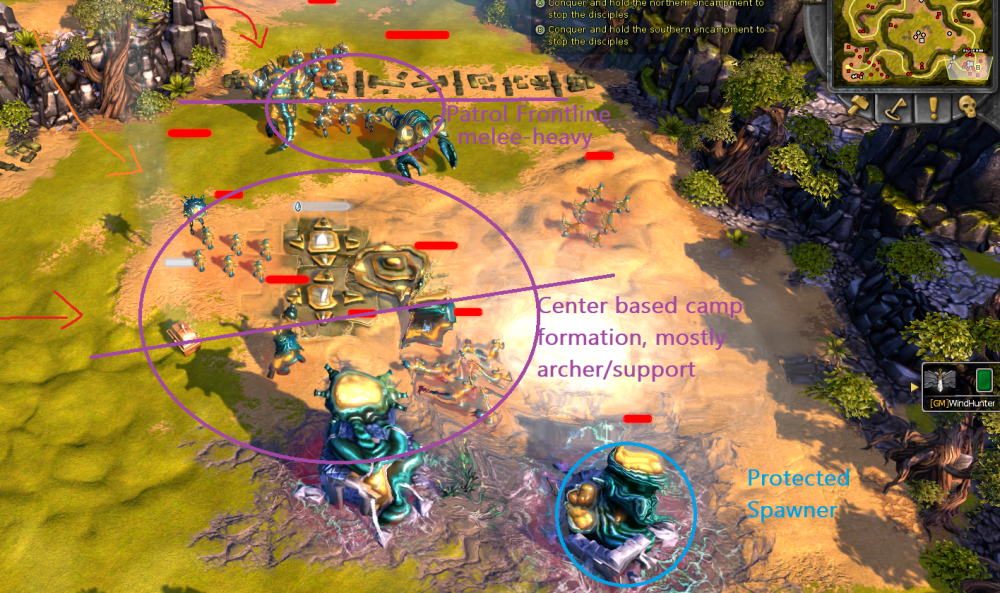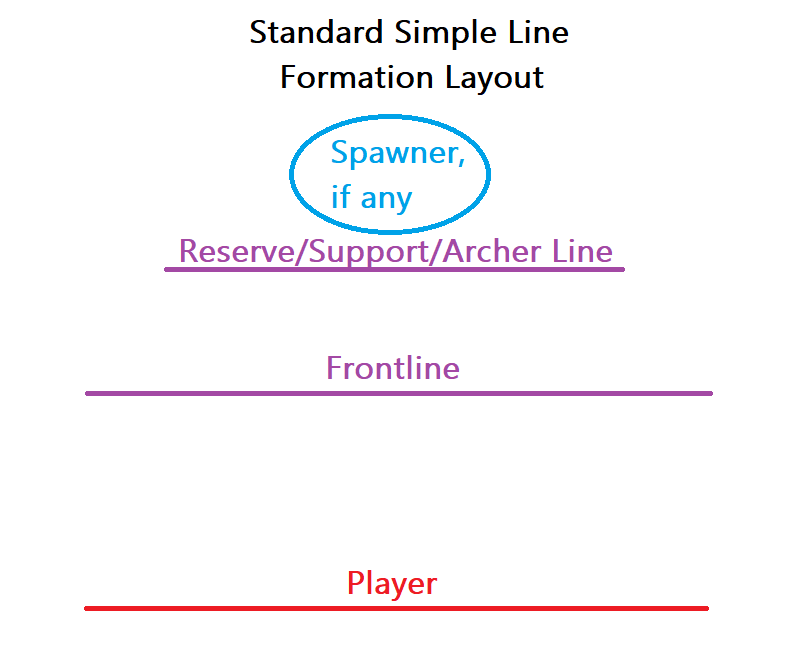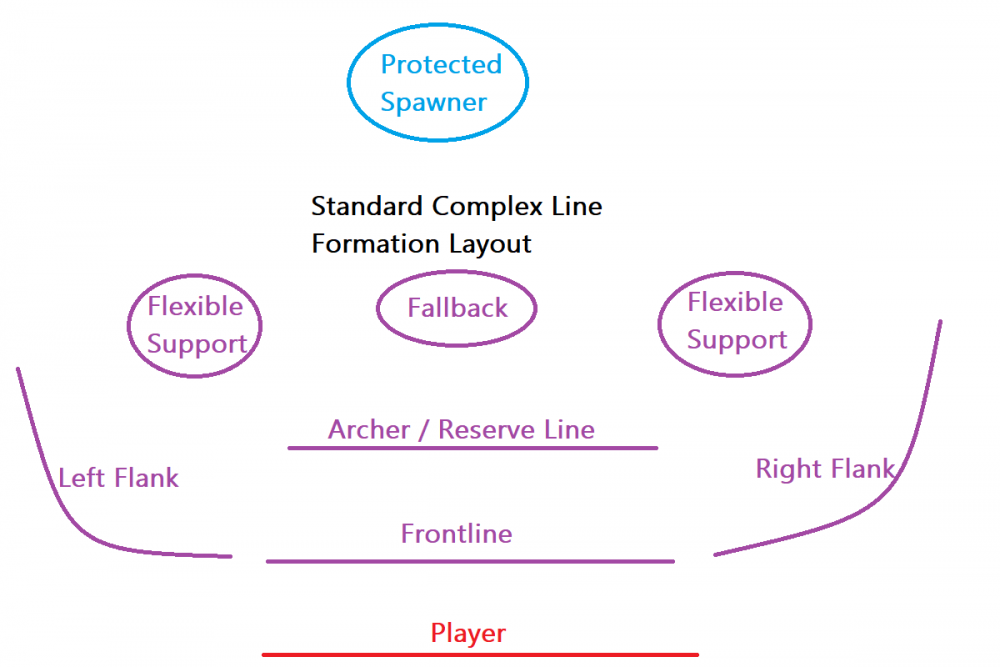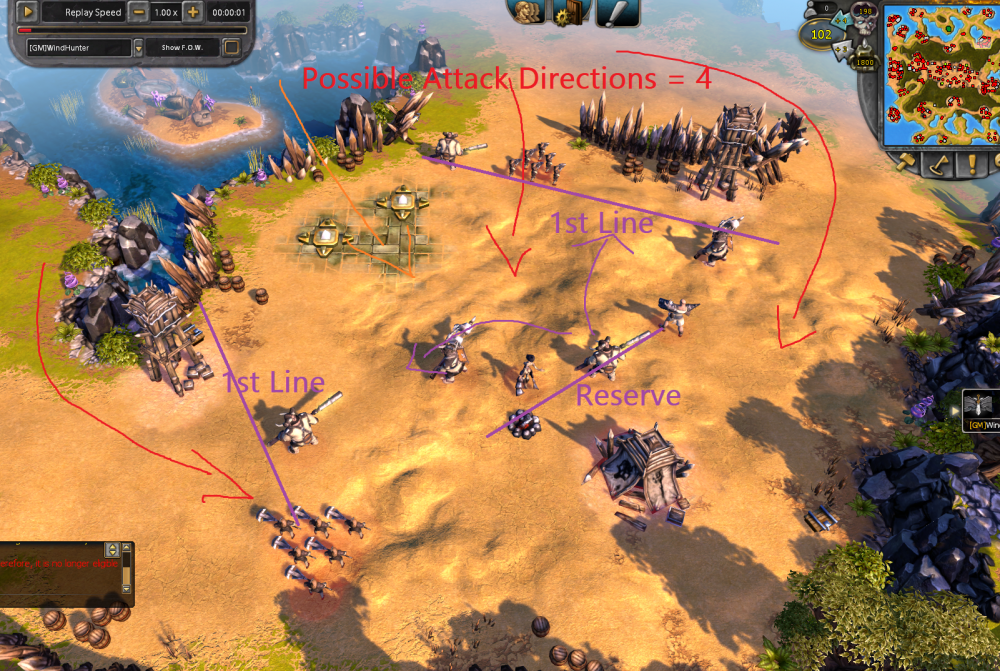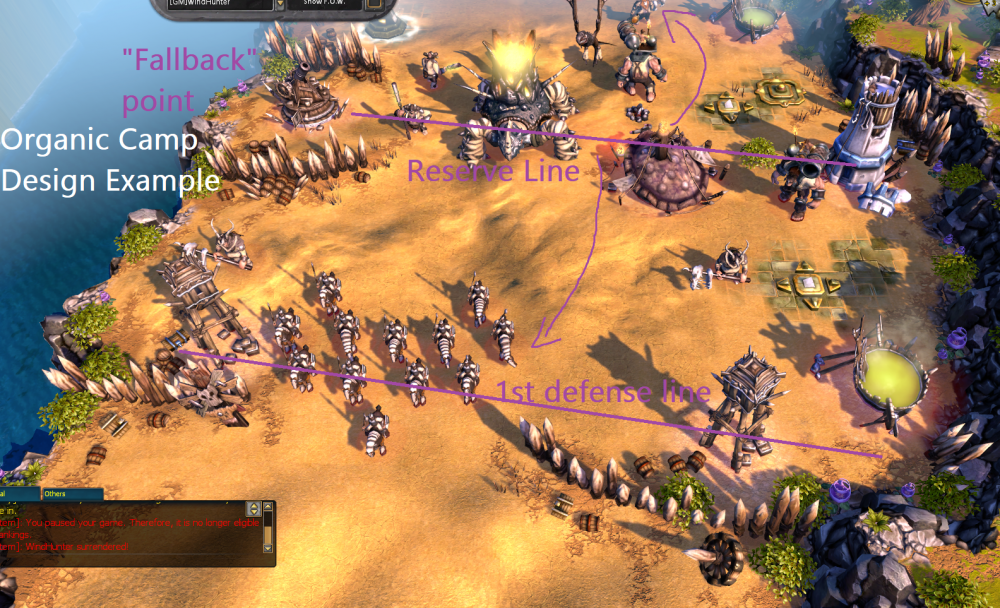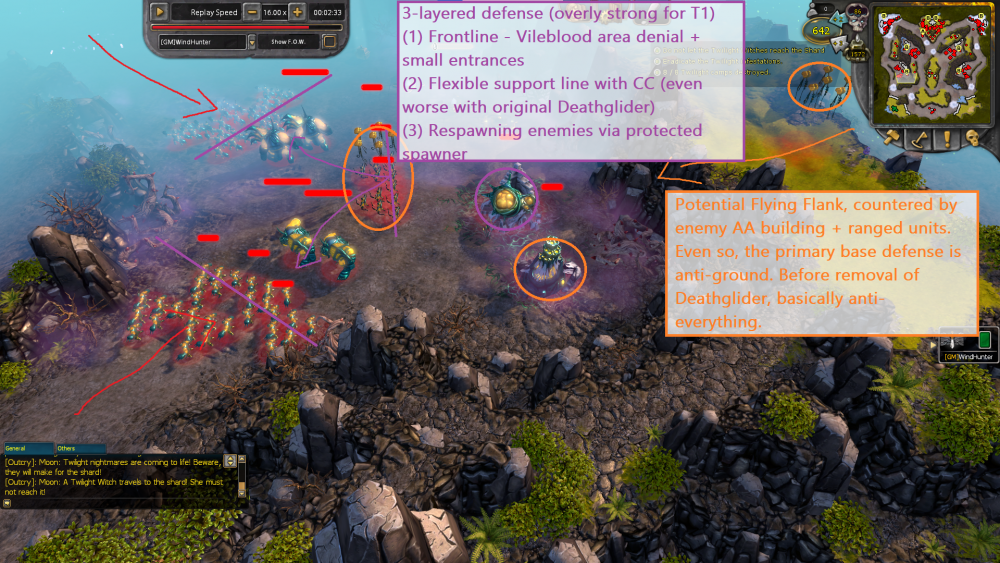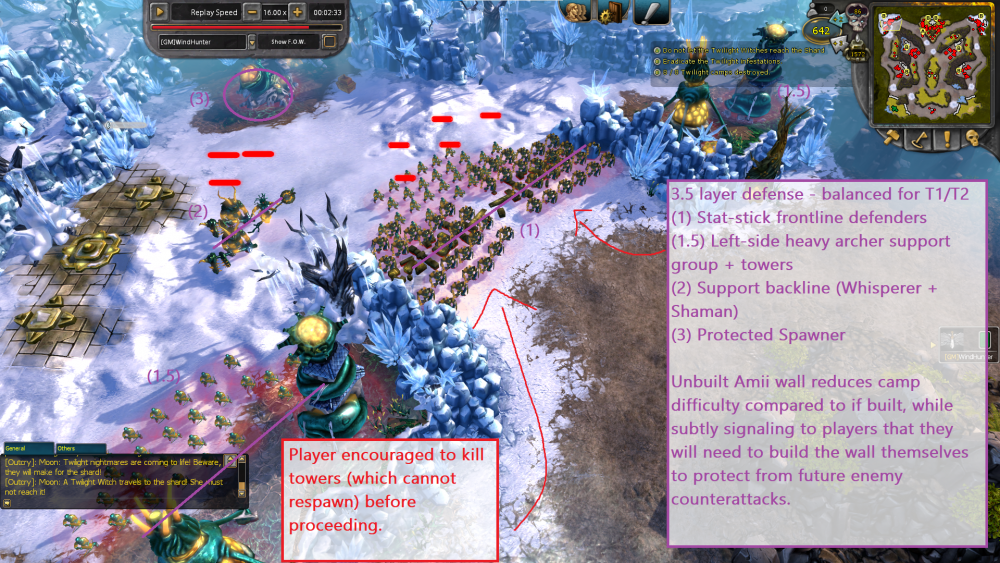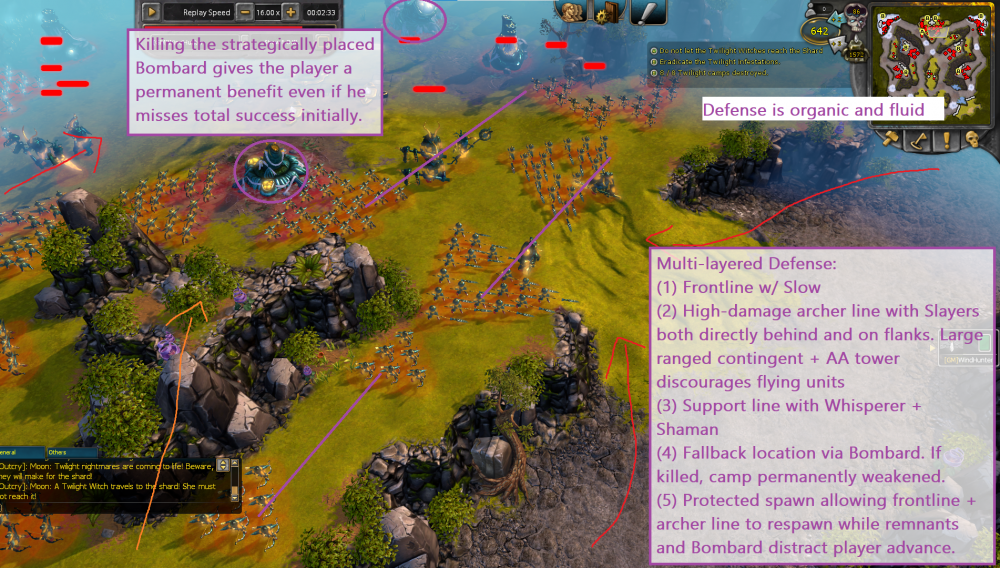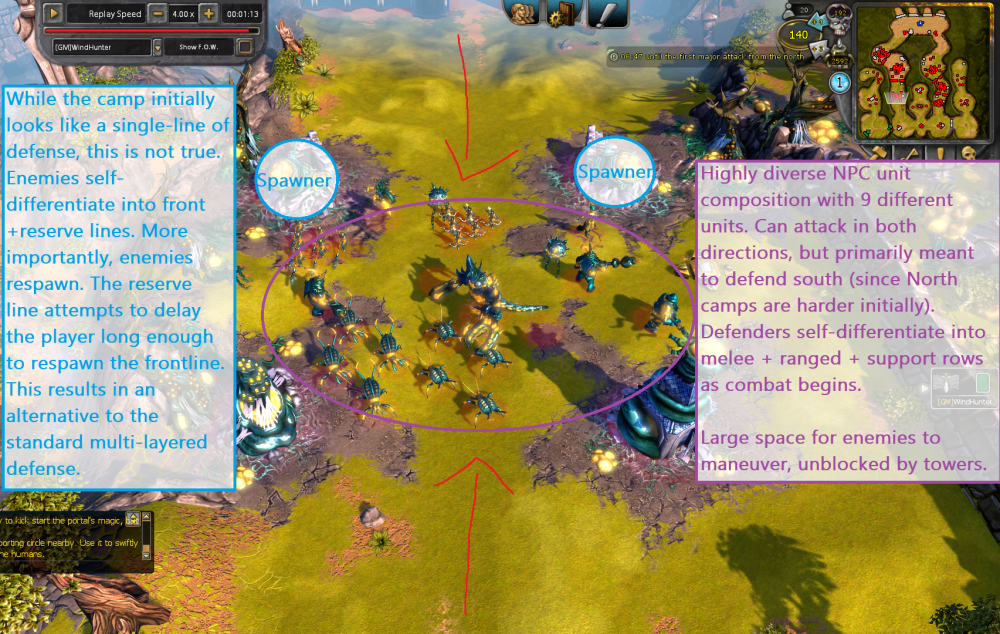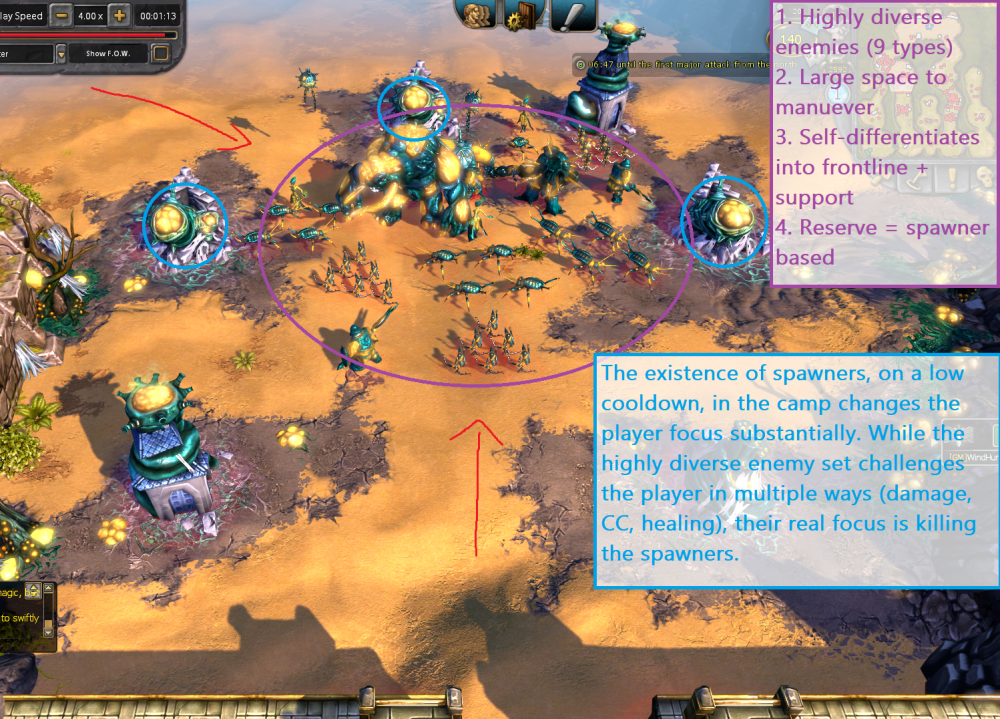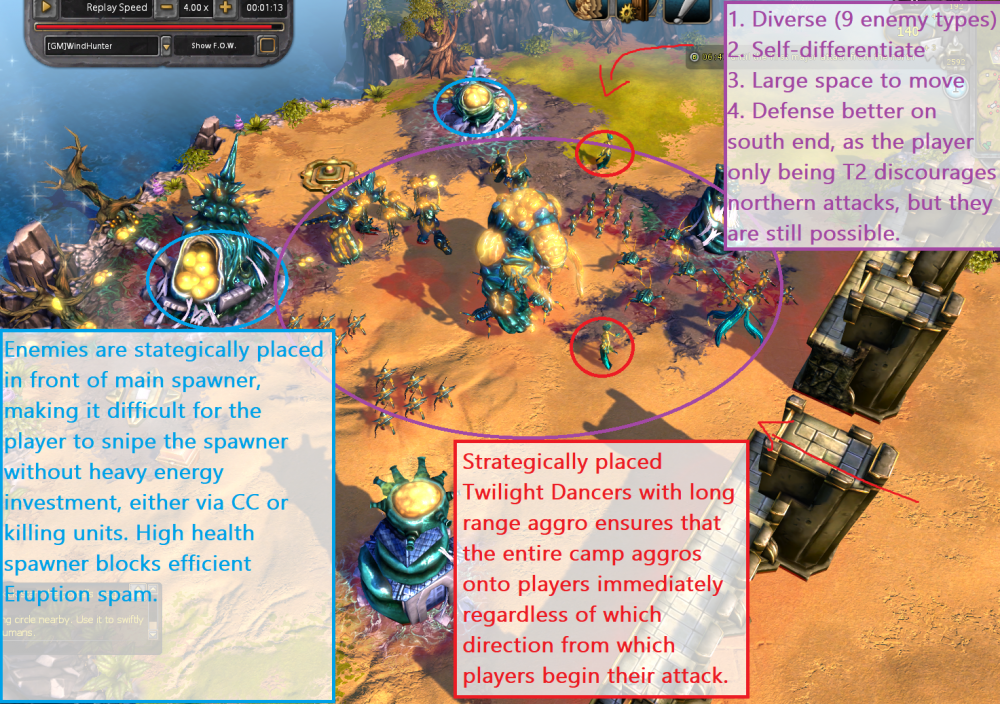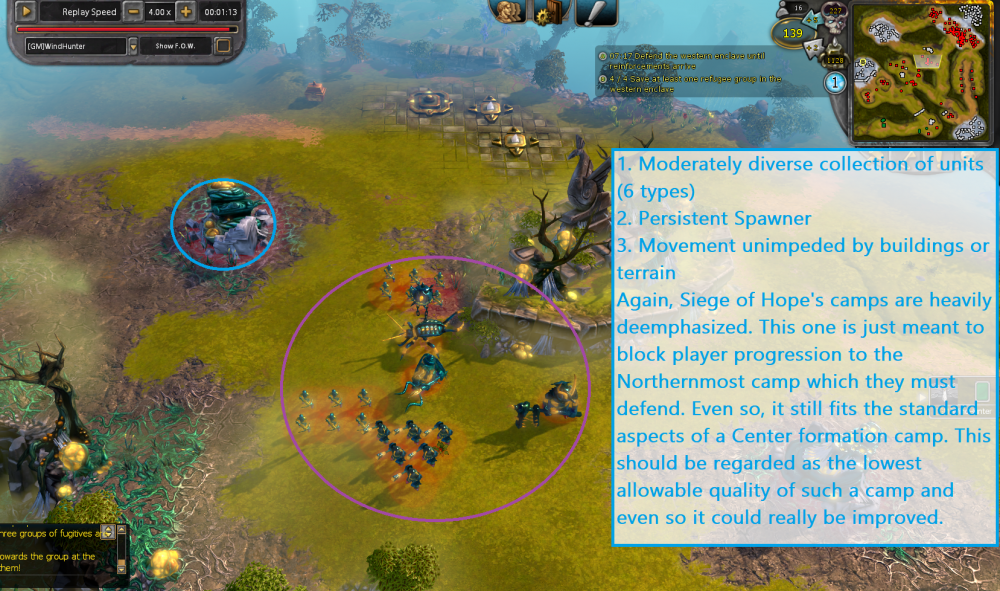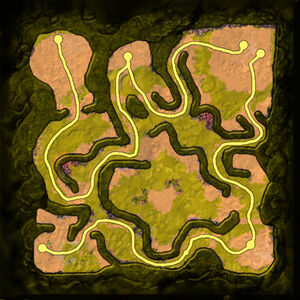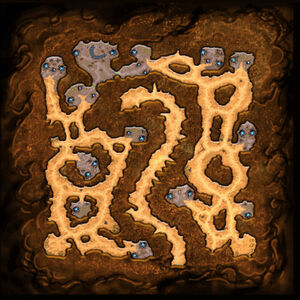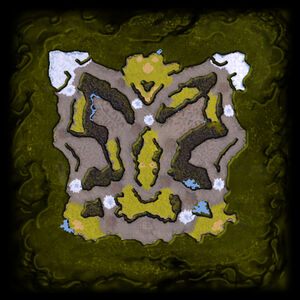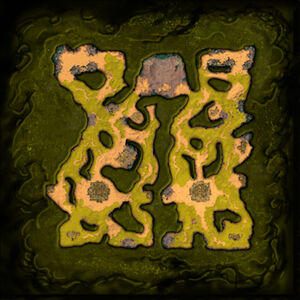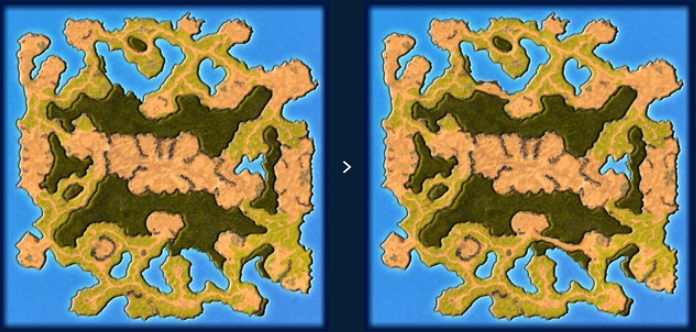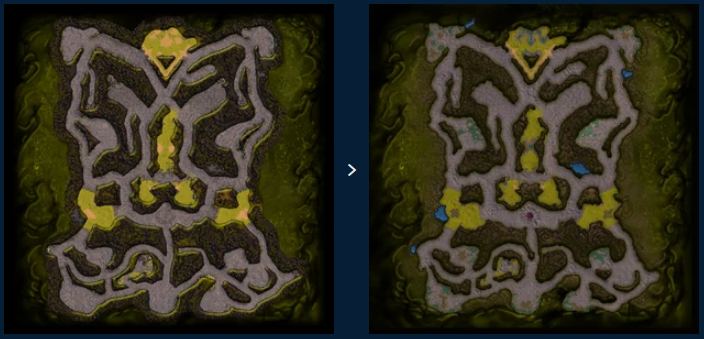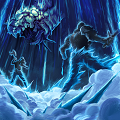-
Posts
340 -
Joined
-
Last visited
Everything posted by WindHunter
-
I think it is worth mentioning here that after community feedback and playtesting, that we have decided to change the Stonekin card which we announced last month, Tectonic Shift, to also affect Frost and Nature buildings. In terms of Bedrock itself, this will open up access to Worldbreaker Gun and Stronghold, in addition to Deepgorge and Stone Launcher, as good companion towers for Bedrock's "Living Rampart" ability.
-
You can read more about the changes to NG and their reasoning here:
-
The issue we face with Deepfang is that we cannot make the critters respawn without allowing the player to spawn infinite amounts of them. This would make Deepfang into a Stonekin Satanael, which we are not interesting in doing. But if we cannot allow the critters respawn, then there will always arise a moment where Deepfang is permanently weaker because of the lose of the critters.
-
The days of wandering in the desert will soon reach their completion. Changes are coming to the achievement alongside the upcoming release of rPvE 9.5.
-
Mapmaking Fundamentals - Spawn Design This was originally written as an internal design document meant to guide our current development of new campaign maps. It has been shared here for interested players and as an aid for aspiring community mapmakers. Introduction BattleForge campaign maps have a particular feel to them, and this feel is a fundamental component of the unique experience which is playing BattleForge. The goal of this design guide is to use existing campaign maps, particularly the best campaign maps, to understand and to categorize the distinct features of the spawns in BattleForge’s campaign, such that we can better design future campaign maps. This guide is therefore intended to categorize the design choices of the original devs and to act as a reference for future development for both community and official map development. Legend Given the nature of map design, this guide uses a high density of visual examples to illustrate map design principles and standard practices. Across all examples, a standard legend is used. Purple – is used to highlight NPC camp formations. Purple text is used to describe the various dynamics occurring in the enemy camp. Light Blue – is used to highlight spawn locations and any special interactions which these spawn locations enable. Orange – is used to highlight non-standard flanking routes available to players. In the majority of cases, orange designates available paths for flying units, but it can also represent potential cliffing opportunities, particularly for artillery units such as Firedancer and Firestalker. Red – is primarily used to highlight player attack routes. It is secondarily used to highlight key features of camps which affect said attack routes. Black – is used to highlight terrain features. Green – is used to highlight map objectives and any locations that might be directly connected to those objectives. Table of Contents 1. Spawn Types 2. Defensive Maps (Defending Hope) 3. Hybrid (Attack/Defense) Maps A. Nightmare's End Analysis B. The Guns of Lyr Analysis 4. Escort Maps A. The Treasure Fleet Analysis 5. Conquest Maps A. Ocean B. Mo Spawn Types Enemy spawns come in four primary types: one-time, timed, conditional, and permanent. These spawn types are not exclusive, in fact it is normal for maps to have multiple or even all four types at once, and often specific spawn interactions constitute multiple types simultaneously. 1. One-time Spawns: These spawns are typically scripted based on the fulfillment of a map objective, such as the Raven fleet’s approach in Ocean when the player clears enough of the center island, or are based on proximity events, such as the many “ambush” events in maps like Encounters with Twilight. Regardless of how they trigger, these spawns only happen once. 2. Timed Spawns: What is meant by timed spawns are those spawns which are primarily triggered based on the passage of time in-game and not player actions or map conditions. These types of spawns are quite rare on their own but are frequently combined with other types of spawns. For example, the permanent spawns on Convoy and Nightmare Shard steadily scale in strength based on the amount of time which has passed. A time component is almost always included in the case of permanent spawns to pressure the player or to keep pace with the player’s growing strength. The attack waves on Siege of Hope and Blight are both conditional timed spawns. If the player fails to kill the spawn buildings in time, a large one-time attack wave is released after a specific period of time. Conditional spawns often contain an alternative time provision. The spawn actives after X objective is fulfilled, or if Y time has passed. 3. Conditional Spawns: Conditional spawns are tied to map triggers which change on their own or due to required player actions. They can be temporary or permanent. Spawn buildings are the primary example of conditional spawners. The spawns are directly tied to the building’s continued existence; destroy the building, and the spawns stop. Many spawners also have additional conditions which must be fulfilled before they begin to spawn units at all. Some spawners only replenish units tied to specific camps, while others only launch attack waves once the player has reached a certain location or has activated a specific trigger condition. In random PvE, only the spawners directly adjacent to the player’s location initially launch attack waves, but if the player attacks a camp and kills an entity within that camp, all adjacent camps also begin spawning attack waves from that point forward. Sunbridge and Slavemaster are examples of conditional spawns tied to player action. In both cases, while the spawns are permanent, the player has the agency to direct the spawn paths via a switch and a fire emitter respectively. In the case of Sunbridge, once the Amii Power Shrines cease to exist, the gate-based spawn waves also cease. 4. Permanent Spawns: Once begun, permanent spawns never stop. This type of spawn is a common feature in defensive maps such as Defending Hope and Guns of Lyr. Non-defensive maps do not typically have unconditional permanent spawns, and if they do, they are typically limited in either strength or location. Mo is an example of a non-defensive map with permanent spawns. Defensive Maps Defensive maps are those maps where the player’s sole primary goal is the defense of an objective or a set of objectives. Any expansion made by the player is meant to better facilitate his defense of the existing objective and not because he needs to conquer additional areas of the map to complete other required objectives. Defense of Hope is the only current official campaign map which is a pure defensive map (Ascension map 1 is the next closest example). Despite only having one such map as an example, we need not fear because Defending Hope is a superbly designed defensive map that contains all the necessary components to teach us how a map designer should design a defensive map’s spawn mechanics. Defending Hope - Spawn Wave Interactions 1. Well Defined Defensive Perimeter – The area which the player must defend is visually distinct from the surrounding area, being protected by naturally existing terrain and buildable walls. This defensive area has overhang spots, occupied initially by Defense Towers, which can attack in a wider arc, as well as plenty of space to build defenses behind the walls. Areas from which enemies normally do not approach are blocked by Lyrish houses, adding an aesthetic flair while also preventing players from building otherwise inefficient defenses. 2. Alternating Attack Waves – Spawn waves on Defending Hope alternative between approaching from the north and from the south side of the city. This allows the player to opt for micro-managing archer units on both the east and west sides, rotating archers between the northern or southern wall depending on which direction is currently under attack. A skilled player can then save up power more quickly to make the transition to T2 or T3. 3. Spread Out, Multi-directional Attacks – While the walls on the east and west sides are close enough that archers can be rotated between them in the early game, they are far enough apart that the player is required to invest in defenses for both the north and south walls on each side, or to invest in a permanently mobile ranged component which can be rotated as needed. This multi-dimensional nature of the defense is important because it keeps the player engaged while also reducing the power of spells. If the units all approached from one-direction, the player would only need to invest in one set of defenses while also being able to destroy most incoming waves with spells, quickly leading to a feeling of stagnation (An example of this stagnation would be position 4 on Bad Harvest, which is initially very challenging, but once defenses are established, becomes dry and boring). With four directions to defend, permanent defenses are encouraged at each location while spells function as a means to plug gaps that form in the player’s perimeter, as their charge limit and cooldown prevent continual usage. 4. Optional Non-fortifiable Expansion Zones – Outside of the singular exception of aiding Rogan Kayle to enter the city, the player need never wander outside of the city’s defined defensive perimeter. Yet, if he choices to, he is rewarded with the possibility of many Power Wells and access to T4. Notably, these areas of expansion are shorn of any means of fortification while also being under constant attack. These means that the player must calculate the potential risk of both venturing forth from the city and investing in additional hard-to-defend assets, but if he proves capable of doing so, he earns himself a permanent benefit in terms of additional power and access to higher tier cards. 5. Permanent & Conditional Spawners – Instead of only spawning enemies from caves, the original designer chose to introduce 4 spawn buildings which the player can destroy. This gives the player more to do, while also forcing him to balance the risk/reward between investing into an expeditionary force that takes power away from the defenses and the benefit of permanently reducing the enemy’s offensive pressure. The buildings themselves have significant defending forces and are XL-spawners with 3200 life points, meaning that the player must do more than just run around erupting them to death. Hybrid (Attack/Defense) Maps Hybrid maps are those maps which mix player responsibilities between attacking and defending. These maps require the player, and any potential teammates, to move forward and conquer new areas of the map while defending map objectives (not Power Wells & Orbs) in other areas. Hybrid Maps: Nightmare's End Nightmare’s End - Player Defense Points & Enemy Spawn Locations The issue with the spawn waves on Nightmare’s End is not so much that spawns can attack every player location on the map, though this is indeed an issue, but that none of the places the player is required to defend are capable of being fortified outside of the initial starting location (which eventually is no longer attacked as the player’s T3 and T4 orbs redirect enemy waves to themselves). Players are required to try and cram defensive structures and units into small areas where buildings often block each other from attacking. These same buildings cannot be built into a coherent frontline due to a lack of space, meaning that even if the buildings placed in the back can attack, they are blocked from reaching the ranged units targeting the building in the front. Additionally, there are no walls or other mechanisms by which the player can slow the enemy’s advance, meaning the frontline units or buildings must also tank the incoming wave. Combined with being the largest map in the entire game by far, making reinforcing areas with existing units nearly impossible, and the fact that enemy waves respawn nearly instantly in close proximity to their intended targets, the spawns on Nightmare’s End are truly a nightmare. Consider then, that after establishing all these defensive networks, the player is suddenly told to abandon them and defend yet another non-fortifiable location from a 5-minute-long onslaught. The fact that this last defense is in no way foreshadowed except for a small wall south of the Forge Shard, is a fitting illustration to how poorly thought through and poorly implemented the spawn mechanics are on this map. A final point worth mentioning about this map is that the trigger conditions for spawning new attack waves and increasing the strength of existing attack waves are poorly defined. For example, one side of the map allows the player to build their T3 without destroying the concomitant Amii Power Shrine within the same camp. This in turn prevents the map from spawning the intended attack waves to attack the player's T3 location, because the trigger for spawning these waves is not the player building their T3, but the Power Shrine being destroyed. Setting aside whether or not the T3 should even be attacked in this manner, the key point here is that the trigger conditions for spawn waves and map events need to be carefully defined to avoid player exploitation. This same issue occurs on Behind Enemy Lines, where the trigger for increasing attack wave difficulty is tied to destroying the Twilight spawn buildings in the T2 and T3 camps. Said buildings are placed in such a way that players can build their T2 and T3 without ever destroying them, thereby trivializing the map in the process. In both cases, simply tying the wave increases to the player achieving a higher tier would have fixed the problem. Nightmare’s End - Southwest Quadrant Hybrid Maps: The Guns of Lyr The Guns of Lyr - Defending Player Progress & Attacking Player Spawn Waves In my opinion, Guns of Lyr is an overly complex, badly designed, and badly balanced map that players have figured out how to exploit in a way that actually makes it enjoyable to play. An entire document could be written solely on how poorly thought through and executed the map's mechanics are in the final product we see in-game. While such a document could perhaps prove useful to the team, we will satisfy ourselves here in pointing out three issues with the map related to how its spawns function. The first is related to what triggers the infected Twilight camps to start sending out attack waves against the player in the "attack" position on each side. These spawns are actually triggered not by the actions of the attacking player, but the defending player. The map suggests to the player, with its set of retreating walls, that the initially defending player is supposed to forfeit their starting base and replace it with the wells and monuments found on the route of the Kobold Engineer which they are told to clear. Simultaneously, the respective side's attacking player is supposed to clear the 3 Twilight camps before transitioning into helping the defender. The issue is that the 3 Twilight camps do not actually trigger attack waves based on interactions with themselves or how much time has elapsed in the map, the camps only replenish defending units lost in attacks on the camp. Instead, the attack waves of these camps are triggered by the defending player attacking the units in camp 1 marked on the minimap above. This in turn leads to a situation where knowledgeable defending players simply do not expand past T2, but wait for the attacking player to reach T4 and trigger the final spawn wave early to end the map. Regardless of intention, it simply does not make sense that the trigger condition for spawning attack waves from these infected camps is tied to attacking that specific location on the map. A valuable lesson can be gleaned from this mistake, which is that spawn triggers for spawn waves need to be carefully defined so as not reward players who exploit the map while punishing those players who engage with the map in the intended manner. The second issue we will discuss in regards to Guns of Lyr is the ability for the player to avoid the map's mechanics and trigger the final spawn wave before actually achieving the necessary map objectives. Map designers need to be cognizant of the ability of players to damage locations behind "impassable" terrain features and take the necessary steps to safeguard these locations or punish the player (in a logical way) for doing so. In the case of Guns of Lyr, the original devs could have responded to the issue in several different ways. An easy method would have been to simply not spawn the final Twilight Manifestation building until the gate was opened, or to shield the building until said condition was met. A more creative approach would have been to immediately trigger other final spawn waves from any remaining Twilight Infestations on the map, making the condition of having to destroy these infestations meaningful, lest these other spawns bypass player defenses and kill Rogan. The Guns of Lyr - Northern Defenses The third and final issue to discuss is how the map's terrain stifles the ability of the primary Twilight attack waves to be meaningful threats by forcing them through single path chokepoints. The map is clearly designed in such a way that the original devs assumed player defenses would steadily move backwards in the face of increasingly difficult attack waves. The map even destroys the original walls in an attempt to force the player to abandon their already constructed fortifications. If players acted in this way, it would cause early waves to attack a single wall, while later waves would eventually attack two and then three walls, spreading out enemies and player defenses over a wider area. The issue is that players do not act in the intended way and are not incentivized by the map to do so. It is always better to defend a single location versus multiple, and it is a hard pill to swallow to voluntarily sacrifice both existing defenses and your starting location, thereby accepting a permanent weakening via lost power and charges. Besides these reasons, allowing enemies to spread out, when you can instead force them through a narrow chokepoint would just be silly. The funnel at the top and bottom of Guns of Lyr clumps together enemies for players to then smash with powerful area-of-effect abilities and spells such as Worldbreaker Gun, Cluster Explosion, and Frenetic Assault. At the same time, the closeness of player defenses means that a single Protector's Seal or Revenge can cover the entire defense, which would not be possible if players voluntarily spread themselves between 3 separate lanes. For the map's defensive gameplay to succeed, it would have to be either more forceful in removing players from the initial chokepoint via harsh penalties or more rewarding in terms of benefits accrued. Another better option would be for the map to spread enemies out initially instead of shepherding them through a perfect kill box. If the devs wanted players to have a last stand location, it would have been better to allow them to set one up directly surrounding Rogan's Stronghold in the center of the map. This would make the map reminiscent of a medieval fortress, with large hard to defend edges that eventually coalesce into a single fortified keep at the city's center. Long story short, do not funnel enemy attack waves through a single narrow chokepoint, spread them out of a wider area or create multiple points of attack to force players to do something more than spam spells and launch Heavy Snowballs. Escort Maps Escort maps are those maps whose primary objective revolves around protecting a non-player-controlled unit as it moves from one location to another. Escort Maps: The Treasure Fleet The Treasure Fleet is the purest form of escort map in the sense that the player has both a direct control of the area around the target being protected, unlike Convoy, and that the target moves forward before the player could have reasonably cleared the route of enemies in any permanent sense. King of the Giants is technically an escort map as well, but it does not feel like one for the vast majority of the map. This is because Rogan arrives far after the player begins conquering the map, so it is less escorting and more clearing a path, and because enemies do not threaten Rogan on the way if the player clears out the pre-existing enemies. These same conditions are not met on Treasure Fleet, and the player is consequently tasked with defending a wagon from the Treasure Fleet as it travels through enemy territory under constant assault. While The Treasure Fleet has a number of issues (which will be discussed later), such as monotonous gameplay, low replayability, and a fixed timer, these issues are largely unrelated to the spawn mechanics of the map. Both the spawn and camp designs of Treasure Fleet are well-done. As the Treasure Wagons move forward, the path itself is relatively unimpeded by walls or permanent enemy encampments, the exception being the Twilight encampment just before the target location which the player can then conquer for himself. Instead, incoming attack waves come from a mix of permanent caves and destroyable spawn buildings built adjacent to the wagon's pathway. The player can choose to only act as an escort for the wagon, or to invest resources into destroying the spawn buildings on the side, making future wagons safer but reducing the resources which can be used to defend the wagon currently en route. At the same time, there are 3 permanent spawn caves, ensuring that players cannot completely eradicate the enemy's capacity to attack. The area around these caves is open, allowing the player space to build defensives without impeding the forward progress of the wagons. There are also a number of optional areas into which the player can expand for additional resources. These side objectives are largely safe from attack, keeping the player's focus on the wagon travel route. The continual focus of the enemy attack waves on the wagon path, along with existence of some of the player's resources on the path itself, is an example of how map and spawn design go hand in glove. The player's own resources are only attacked where it makes sense for an enemy obsessed only with the Treasure Wagons to be attacking. Despite a well designed layout and well scripted spawns, The Treasure Fleet suffers from several balance problems and core design issues. I think these are worth pointing out because it is important to understand how multiple small issues can drag down an otherwise well designed map. The first major issue is that the map has a fixed time limit which cannot be meaningfully changed outside of early game exploits via killing one of the wagons. While this is fine for a few playthroughs, it severely damages the map's replayability, which is the second major issue. A good player quickly learns how to exploit a map's weaknesses to achieve objectives in creative manners and this accumulated map knowledge is typically rewarded with an easier playthrough, or better, a faster completion time. What happens with veterans in The Treasure Fleet, assuming it is played normally without the early wagon kill, is that veterans quickly and efficiently destroy enemy spawn buildings, grab early wells for fast power generation, and neutralize the spawn caves whose attack waves are easily destroyed due to not being guarded by map terrain or reinforcements. By the time the last 1-2 wagons spawn, the player has already beaten the map and merely needs to repair the odd tower while they scroll social media waiting for the wagon to meander its way to the finish line. In other maps, the player's high level of proficiency would lead to a faster conclusion to the map itself, providing a meaningful way for a player to measure their own improvement and to show off. While you could post a replay showing you cleared the map of enemies faster than other people, the fact is that this is not an easily quantifiable measure of skill because it does not show mastery of the map as such, in the same way that faster map completion times do inherently. Also, no one is going to watch the replay. This issue would have been fixable through mechanics such as the ability to reroute a wagon via a faster but more difficult route, or the ability to release multiple wagons at once but by doing so, the player triggers much harder attack waves as a result. Such mechanics would have required much more complex map scripts to achieve and given the time necessary to achieve this, and the fact that the original devs, based on the abilities of the Twilight Edition cards, seemed to believe PvP would be the more popular mode, it is not that surprising The Treasure Fleet was not given the love necessary to generate long-term replayability. Conquest Maps Conquest maps are those maps whose primary objective is to clear the map of enemies, potentially culminating in a boss fight which triggers the map's end. Lodgement maps, as discussed in the companion camp design guide, are a type of conquest map. Conquest Maps: Ocean The majority of gameplay in Ocean is fighting on different islands made up of different combinations of center and line-based camps. These sections of the map are largely uninteresting for our purposes here. Besides island hopping, Ocean has an additional mechanic, which is that Raven Battleships spawn in from 8 different locations around the edge of the map, and if these Battleships succeed in assembling a fleet of 5 ships, the player loses. This mechanic is a good example of creative spawn scripting, which is well integrated into the map and its lore, and which adds a dynamism to the map that helps make each playthrough a bit different. I would also note that I personally think semi-randomized spawn events of this kind make for a better map experience because they make the map feel more alive. In general, I think Ocean does a very good job of making the map feel like a real location and not just a videogame map to play in. While some islands feel silly, such as the tiny ones populated by ground troops, others like the Skyrake island do a good job of both sticking to the standard enemy faction of Bandits, while also feeling like a place where Skyrakes might actually populate and breed. This feeling of life is helped by a large number of one-time map events, such as the bird attack at the beginning, the mines which spawn on the western isle, and the ability to earn Skyrakes for yourself when you conquer their island. This is a good reminder that one-time spawn events play an essential part in making the level feel alive and lived-in. The existence of the Deathray summoner, which seems a bit random when reflected upon, but which is an iconic part of the map, is another reminder that sometimes it is okay to add a twist to the map. After the player reaches the main island, a second Raven ship mechanic activates which spawns Raven ships along the entire edge of the map hellbent on killing the trapped white juggernaut. This is an example of a bad spawn mechanic. The massive invasion comes out of nowhere, is never foreshadowed, and it is poorly executed. Most of the islands and base locations which get attacked by the incoming ships lack the ability to respond to attacks due to the twin factors of little space to build and the fact that Raven Battleships have a 50m range and can fire from fog of war. While this is functionally the boss battle of the map and therefore it is not necessarily wrong that the player's bases are put under real pressure, the issue is that the map itself is not built to facilitate such a fight. In the first part of the map the arrival of each ship is foreshadowed and the player can prepare by building towers and moving units, but the same is in no way true here. The confusing part is that this omnidirectional attack is then followed up by a single direction attack from Blight which seems much less scary in comparison. The final Raven fleet fight would likely be much better if the fleet came from 1-2 directions, instead of all directions, but that the chosen locations were still semi-randomized so that the player could not preemptively defend against it. I personally would have made the existence of the incoming fleet be foreshadowed similar to the singular Raven ships, while giving the player a 1 minute timer to rapidly prepare some defenses in the direction which got chosen. I then would have made Blight appear with ships from all directions to provide a better sense of hopelessness and impending doom, thereby making sense of Mo giving into QueekQueek's blackmail due to a real worry for his life. Conquest Maps: Mo Mo is simultaneously a well designed and a poorly designed map, which is why it alone has been referenced in both the spawn and camp design guides. The general idea of the map, the player getting to control a boss-like NPC unit which he needs to safely guide to the end, is simply a great map concept. The power fantasy of playing as Mo and singlehandedly smashing through Bandit defenses, helps to give the player a real sense of why Mo is treated as such a threat in universe. In terms of sections, Mo is split into three distinct parts. Each of these three parts have substantially different spawn patterns and each have a lot to teach us about good versus bad spawn design. In the first section, Mo smashes through half-camp after half-camp until reaching the player's T3. While passing through this section, Mo activates 3 permanent spawn caves which continue to vomit flying units for the entire rest of the map. These hostile fliers can kill every well and orb from the player's starter base to his T3. After reaching the player's T3, Mo turns north to fight a mini-boss in the form of Banzai Lord. Banzai Lord spawns Banzai Birds, which Mo can either kill or play hide-and-seek with on his journey northward. The layout of this section facilitates both playstyles, giving the player several safe zones where they can stop and heal their ailing juggernaut. Once the Banzai Lord is dead, the Banzai Birds stop spawning and this section remains permanently safe. The third section, which was discussed in detail in the camp design guide, is then mostly self-contained and functions as a lodgement map. The lodgement section makes use of conditionally permanent spawn waves. Enemies spawn from caves, the spawners are therefore indestructible, but once the condition is met (death of Raven Command Walker or Bandit morale reaching 0) the spawns permanently cease. If the spawn locations themselves were moved and the waves spawned less frequently, to allow players to avoid and hide from patrols while otherwise slowly gaining ground, the third section would be very well designed overall. While the third section's spawns feel less organic than the second section's, the concept of Bandit morale is very sound and lacking only in the fact it is hampered by the issues mentioned above. Speaking of the second section, little needs to be said. The whole area is done so well it is a clear example for how Skylords Reborn map designers should design such areas in their own maps. The real issue with Mo's spawn design is the first section. The spawns are clearly intended to place continued pressure on the player as a kind of failure condition. This was likely done because Mo can simply be held back and he is therefore never in real danger of death. If the player were to do that, the player would never be able to fail the map. In light of this, the original devs added the need for the player to continually defend his T1-T3. The issue is just how ham-fisted the whole thing feels in terms of implementation. Does it really make sense that there would be an infinite spawn of only Skyrakes and Windhunters? In terms of map art, it looks like the player disturbed some bird nests and it therefore makes sense that some flying units would spawn in response, but why do they eventually turn into Tortuguns? Overall, the whole bird spawn mechanic just feels like a band-aid to a mistake made in map design which likely could have been fixed in another way. If you look at the picture included above, you will notice that the first and second sections of the map have the same mountain + green field look. Given their connection in aesthetics, it would have been better to connect them in terms of spawn mechanics as well. If I were to remake the map, I would have tied the spawns in the first section to killing the Banzai Lord in the second section. This gives a reason for why the birds were attacking to begin with, because they belonged to the Banzai Lord. The fact that the player would no longer be able to lose permanently after that point is fine, there are plenty of other maps where this is true, and technically they can still lose by letting Mo die which is likely the more common failure condition anyway. The key lesson to takeaway here is that true permanent unconditional spawns should be very rare in maps; it is almost always better to implement conditional permanent spawns when you feel like you need to pressure the player in this way.
-
We do a new survey every year in the summer. Some of the questions stay the same, so we can measure changes in player sentiment, while others are removed or added due to relevance and changes in priorities.
-
Mapmaking Fundamentals - Camp Design (Cont.) Area Formation - Lodgement The type of camps a map designer employs has a major effect on the feel of both the map in its entirety and also specific subsections of the map. For example, Mo, which will be discussed below, transitions from a one-path map from T1 to T3, to a lodgement map in T3 & T4. Camp formations in Mo then transition types accordingly. Lodgement maps, or map subsections, are sufficiently different from normal maps that they deserve particular attention. In these types of maps, the player is required to progress and conquer land, as normal, but under the constant threat of permanent or semi-permanent enemy patrols. The patrols occupy a large portion of the enemy power budget, leading to a situation where the camps themselves are often of reduced strength. Many camps in lodgement maps are in fact only half-camps, containing only some of the aspects of line or center-based camp formations. The reason for these seemingly incomplete camps is that lodgement maps are not balanced on a camp-by-camp basis, as is true in the previously discussed maps like Blight and Crusade, but as an area. While each camp on Blight is self-contained, the entire area of a lodgement map should be regarded as a single complex line camp formation. This also means that strategic depth in the given area is not measured camp-by-camp but area-by-area. To help demonstrate this, we will discuss several examples below via visual illustration. Lodgement Formations: Encounters with Twilight Encounters with Twilight - Lodgement As already mentioned, many lodgement style maps feature a series of half-camps guarded by permanent or semi-permanent patrols. In the case of Encounters with Twilight, each half-camp, or strongpoint, is functionally equivalent to a non-respawning frontline. The patrolling Vileblood and Whisperers function as reserve and support lines respectfully. This design encourages a player to either preemptively destroy patrols or to avoid them altogether to isolate enemy strongpoints which are weak on their own. The patrol units in a lodgement map are highly relevant to the player’s experience, and Encounters with Twilight’s patrols are a masterclass in good camp design. The patrol’s primary goal is to hamper or repel player advances against NPC strongpoints. Since these strongpoints do not respawn, every time a player is able to destroy a target, they permanently weaken the area’s defenses, reducing its strategic depth. Vilebloods therefore represent the perfect reserve line as they can either prevent forward progress until the support arrives via their area of denial on-death effect, or they can force a player forward into an enemy strongpoint by blocking the path of retreat. The Whisperers are good complements, able to function both as a support and archer line. Their damage is decent; they can heal multiple allies simultaneously, restoring the integrity of damaged strongpoints; and provide a large area blind. This creates a dichotomy. The Whisperers discourage ranged units, while the Vileblood discourages slow melee units. Many veteran players of Encounters therefore lean towards swift melee units like Burrowers to snipe strongpoints while avoiding the incoming patrols. Lodgement Formations: Mo Mo - Half-camps If Encounters with Twilight’s patrols are a masterclass in good lodgement area design, Mo’s patrols are the prime example of what not to do. In this section of Mo, the half-camps, or strongpoints, function as the archer and support lines while the patrols represent the frontline. This is a solid design and the strongpoints themselves, both the half-camps shown above as well as the various towers stationed on the center plateau, are well designed and interesting. The issue is that the player will almost never reach these strongpoints to claim them for himself until after the patrols have stopped spawning. This happens primarily because the patrols are too strong, and their spawn points are badly placed. In Encounters with Twilight, the patrol spawn exists at the point farthest from the player’s initial entry into the area. In Mo, the patrol spawns are located closer to the player than the vast majority of strongpoints. Additionally, the northern spawn is so close to the player’s intended strongpoint that it actually becomes a liability for the player to attempt to establish a beachhead in what otherwise should represent an ideal location to facilitate further conquest of the area. The primary lesson to learn from Mo’s bad example is that not only the composition of patrols is important, but also their location. Patrol spawns should be located as far as possible from the player’s initial entry and expected expansion into the lodgement area. This gives the player the ability to expand without having to worry about enemies spawning in the very midst of what should now be conquered territory. Additionally, it allows the player more time between spawns to move forward and capture and/or degrade enemy strongpoints in preparation for total conquest of the area. Lodgement Formations: Behind Enemy Lines While the above 2 maps have lodgement sections, Behind Enemy Lines is a giant lodgement map. The player starts in the center and is required to slowly expand outwardly in all directions under constant siege while preventing the enemy from generating more powerful patrols via Twilight Disciples. Behind Enemy Lines is the synthesis of all the ideas we are covered so far in this document, and it is therefore the perfect conclusion to our analysis of BattleForge’s camp design. Behind Enemy Lines - Expansion Zones Zone 1 – Vulnerable initial starting zone. Zone 2 – Half-camps supported by patrols. Natural expansion zone, guarded by terrain features. Zone 3 – Hybrid camp design. These camps are simple line & center-based formations simultaneously with destroyable spawners. Fortifiable by the player post-conquest, also permanently reduces patrols and naturally intercepts disciples. Zones 4 & 5 – Complex line-based formation camps. Permanently safe locations once conquered. Final Camp – Multilayered complex line-based formation camp. Map ends when destroyed. When considered zone-by-zone as just outlined, it is easy to see that Behind Enemy Lines moves from simpler to more complex camp formations as the map progresses. Each zone also gives the player tangible benefits, such as a more easily defensible location, easier access to the Twilight Disciple path, and periodic permanent reductions in the quantity of patrols. In exchange though, the player must now defend an increasingly larger portion of the map. Additionally, both permanent spawn locations are sufficiently removed from the player’s own strongpoints and are located outside of the natural progression of the map. This gives the player options in how to respond to incoming threats. Finally, the map contains a large mix of terrain features. Chokepoints are connected to wide pathways, which are flanked by cliffs, both favorable and unfavorable. This allows the player a plethora of ways in which to approach the map. Behind Enemy Lines - Zone 3 South, Hybrid Camp Design Appendix I: Standard Camp Layout Diagrams
-
Mapmaking Fundamentals - Camp Design This was originally written as an internal design document meant to guide our current development of new campaign maps. It has been shared here for interested players and as an aid for aspiring community mapmakers. Introduction BattleForge campaign maps have a particular feel to them, and this feel is a fundamental component of the unique experience which is playing BattleForge. The goal of this design guide is to use existing campaign maps, particularly the best campaign maps, to understand and to categorize the distinct features of the camps in BattleForge’s campaign, such that we can better design future campaign maps. This guide is therefore intended to categorize the design choices of the original devs and to act as a reference for future development for both community and official map development. Legend Given the nature of map design, this guide uses a high density of visual examples to illustrate map design principles and standard practices. Across all examples, a standard legend is used. Purple – is used to highlight NPC camp formations. Purple text is used to describe the various dynamics occurring in the enemy camp. Light Blue – is used to highlight spawn locations and any special interactions which these spawn locations enable. Orange – is used to highlight non-standard flanking routes available to players. In the majority of cases, orange designates available paths for flying units, but it can also represent potential cliffing opportunities, particularly for artillery units such as Firedancer and Firestalker. Red – is primarily used to highlight player attack routes. It is secondarily used to highlight key features of camps which affect said attack routes. Black – is used to highlight terrain features. Table of Contents 1. Player Agency - Angles of Attack: 2. Camp Formations – Line vs. Center Based A. Simple Line-based Formations (Blight) B. Complex Line-based Formations (Nightmare Shard) C. Center-based Formations (Crusade & Siege of Hope) 3. Area Formation - Lodgement A. Encounters with Twilight Analysis B. Mo Analysis C. Behind Enemy Lines Analysis 4. Appendix I: Standard Camp Layout Diagrams Player Agency - Angles of Attack BattleForge is a game well beloved for how much agency it gives to players. Players can choose which modes to grind for rewards, which cards they collect, how their decks are constructed, and how they approach each map. The continued cultivation of player agency has and must continue to inform map design. One of the most prominent aspects of player agency is how a player can approach a map, which enemies they fight, which paths they follow, and how they attack any given camp. Given this document’s focus on camp design, it is worthwhile to start our analysis by visually highlighting a good example of camp design which enables player agency by a multiplicity of angles of attack. In nearly every example shown in this document, there are a number of red and orange arrows highlighting some of the available angles of attack for each given camp. I strongly encourage the reader when following along in the analysis of each camp to also consider how the original devs used the terrain features and enemy layout to enable and disable different angles of attack; the reader ought to then consider how this affects the player experience in both positive and negative ways. The diversity of approaches both within and between camps is one of the major factors that contributes to BattleForge’s maps remaining interesting even after dozens of playthroughs. Blight Enclave 1 - Northeast Camp Formations - Line vs. Center Based In general, the vast majority of camp designs in BattleForge’s campaign maps fall into 2 distinct categories, line-based and center-based camps. Line-based camps are so called because the enemies in the camp are visually aligned into line formations, similar to real life pre-modern army arrangements. Each line is typically made up of only a couple different types of units and both the front and reserve lines are often supported by buildings. Center-based camps are so called because the enemies in the camp are clustered in the center as a group. While initially clustered, center-based camps quickly self-differentiate when attacked. Contrary to their line-based counterparts, center-based camps are highly diverse, utilizing as many different enemy types as possible but with a deemphasized focus on towers. Simple Line-based Formations: Blight The majority of camps in Blight fall into the category of simple line-based formations. What this means is that the camp is made up of 2 lines, a frontline and a backline. The frontline is typically melee units, a support building (Waystation), and towers. The backline is composed of support units or buildings (Shamans, Bandit Sorceresses, Waystations), long-range backup (Bandit Sniper, Artillery), and melee reserves. While higher tier camps have increased unit diversity, most simple line-based camps make use of only a small number of distinct units in each line. Diversity is more to be found between the lines than within them. While most camps have spawners, these are usually not the focus of the camp, with several only being triggered by the global map timers. In all cases, while the camp itself is fortified, it also feels lived in. When looking at the camp, the defensive formations are believable, and the player can imagine that the Bandit camps also double as homes. Blight Enclave 2 - Southeast Blight Enclave 3 - West Complex Line-based Formations: Nightmare Shard Nightmare Shard’s design revolves around defending the Forge Shard and destroying 4 camps, each of which is themed after a different element. Each of the four primary camps falls into the category of complex line-based formations. This type of formation is a more complex version of the simple formation illustrated above by the examples from Blight. While simple line camps only have a front and backline, often with no spawner, complex formations have multiple layers of defense and almost always make use of a well-protected spawner. The general design idea is that the frontline, largely made up of melee units, impedes the player’s initial progress, while being kept alive by a possible support line. Simultaneously, an archer line, made up of ranged units and towers often protected by terrain or walls, provides the primary source of damage. Once the frontline dies, the archer and support lines, still protected by towers or a fallback artillery location, delay the player until the frontline can respawn from the spawner farther back. These types of camps at their best create the feeling of a great ongoing battle where the player slowly and steadily advances against the enemy. At their worst, they feel like an unending slog against a never-ending horde. Nightmare Shard - Shadow Camp A major factor that determines if the camp is enjoyable or frustrating is how the camp manages strategic depth. In the 3 examples included here, the strategic depth of the camp is handled significantly differently. In the first example above of the Shadow camp, absent Mana Wings or leaving the camp until post-T2, the player is forced to attack into small chokepoints with no capacity to retreat due to the wild magic zones. Paired with enemy Vilebloods, whose death temporarily blocks any forward progress, this often leads to a choice between reaching the spawner but sacrificing a large portion of your army to Vileblood acid; or delaying to save your army but facing a second wave of Vilebloods. Choices such as these are frustration fodder because the player feels trapped into making a bad choice with little capacity to adapt. Still, the distance between the spawner and the initial engagement zone is very small, and if this were a T2+ camp it would likely be well balanced given stronger player damage and CC spells. In general, lower tier complex formations should have lower strategic depth, measured here as the distance between the initial engagement zone and the priority target, as well as the capacity of the enemy to continue fighting. Nightmare Shard - Frost Camp The Frost camp is an example of a fully fleshed out complex line-based formation. There is a center frontline, with both an archer line and support line directly behind. The sides have additional archer lines (towers + ranged units) which can continue to attack the player if they try to run for the spawner, which is well protected at the very back of the camp. This overlapping multi-layered defense is the major component of any complex line formation. It is also believable. Given the available troops, the arrangement of the Twilight forces makes logical sense. A player given the same troops would likely place them in a similar fashion. Another key part of all well-made complex formations is permanently destroyable strongpoints. In this case, the Frost camp is formidable not just because the units can respawn, but because the towers help to hamper forward progress. When the camp is originally encountered, it is at its strongest. But, if players are careful and destroy the towers before launching a full assault, they increase the chances of taking the camp without being repealed or losing most of their forces. This creates a give-and-take with the camp where it feels like the player and the enemy are actually matching wits against each other. The best complex line formations have a strategic depth that can be degraded or circumvented by smart players, but which acts as a formidable wall to the reckless. Nightmare Shard - Nature Camp Similar to the Frost camp, the Nature camp has multiple layers of defense. The Twilight Pikemen slow enemies while they get damaged by a substantial contingent of Twilight Slayers and a well-positioned Twilight Bombard. The camp has 3 forms of CC: slow, blind, and M-knockback. These make it very difficult to reach the spawner which is located very far back in the camp. While the ultimate goal is the spawner, the Twilight Bombard is provided as a solid secondary objective. By destroying it, the player makes any subsequent attacks on the camp much easier. Additionally, one of the most intriguing aspects of this camp is that, absent the single Bombard and Whisperer, all other defenses are T2 or below, while the camp is a T3 camp. It is the perfect example of how a well-designed camp with significant strategic depth can provide a challenge even to higher tier players without the need to utilize stereotypically powerful units. This camp also well illustrates that many complex line formations make use of only a few units with little compositional diversity in the camp as a whole. Center-based Formations: Crusade Crusade - West Bottom Camp Crusade - West Middle Camp Crusade - West Top Camp Center-based Formations: Siege of Hope Siege of Hope - Western Enclave Siege of Hope - Town Guard
-
We will do doing just this, yes. The existing level 10 achievement will be moving to 9.5 (6 booster one). A new cosmetic-only achievement exclusively for level 10 will then be released alongside it.
-
We are looking into the possibility that we accidentally changed some portions of LS. I will ask around to see if there has been any update.
-
Hello everyone, it has been 10 days since the last patch and it is time for our next feedback thread. You can discuss it both here and on our balancing discord: https://discord.gg/jrGEBG9NT5 What did you like, what did you not like? Do you want to see more of some things and less of others? Below are some topics to help begin the discussion: Thoughts on the many quality of life features released with the patch? New card feedback How does Nature rPvE feel? June MotMs will be set to Nature if you have not been able to play it much yet. Opinions on balance changes? We tried to add several improvements to T1 & T2 through both buffs/reworks and reducing card orb requirements Current balance between the various void return methods How does Stonekin feel post-patch? Do towers feel like they are in a good place (minus the still-pending changes announced months ago)
-
Thanks for the report, we will be fixing this.
-
Just confirmed, the daily quests were missed in the scramble leading up to the patch and have not yet been changed to count cards used when playing featured community maps.
-
There are, generally speaking, 2 types of effects: internal and external. This is true for both damage buffs and damage reductions. An internal effect is one which a unit or building applies on itself or which is possesses passively. Two examples would be Moloch's Hardened Skin and Imperial's Defensive Stance. An external effect is one which is applied by an effect outside of the unit or building. Two examples would be Lifeweaving and Stone Shell. Internal effects stack infinitely with each other. So Wrathblades' Burnout damage buff stacks with Wrathblades S-counter damage buff. External effects stack with internal effects but not other external effects. Only the strongest external effect is chosen. There are a few exceptions to this all. Ward of the North, Revenge, Lifestream, Ice Shields, and other such abilities are actually redirect abilities. These stack with 1 non-redirect external effect and all internal effects. Redirect effects do not stack with each other. Another exception is Unholy Power, which, to my knowledge, stacks with everything.
-
The community map achievement could have been announced better. The issue is that there are not enough community maps of sufficient quality with completed advanced and standard modes. We decided to treat the Forge skin as equivalent to a new promo card and therefore placed it behind a veteran level achievement. We might make adjustments based on the data with get in the next month or so. The next Forge skin will release differently.
-
It is 3 total. The ability wording takes into account the unit which is activating the ability. So the unit itself + 2 others. Most minimaps are at least somewhat inaccurate as regards terrain and more significantly inaccurate as regards foliage and such. We only changed the things we mentioned and we took the opportunity presented to fix as much of the minimaps as possible.
-
Since I have now seen this a few times: Frost Mage was not nerfed. We fixed the knock back bug it has had since game release. This is at minimum a bugfix, at maximum a buff.
-
Map & NPC Changes [ NPC Balance Changes ] Lost Reaver: 1. Reclassify Lost Reaver as a melee-unit instead of a ranged-unit. Players are likely familiar with the fact that a Lost Reaver will spawn its Lost Crawlers and then stand off to the side while it and its allies are slaughtered. This has now been fixed. Lost Reaver will use its ability and move towards and engage enemies in melee combat. This should constitute a slight buff to the unit's strength as an enemy. Lost Wanderer (shield variant): 1. Ice Shield duration: Infinite ➜ 20 seconds 2. Targets: All available targets in a 20m radius ➜ 5 closest units in a 20m radius 3. New passive effect: The duration of friendly Ice Shields is extended indefinitely within a 20m radius around Lost Wanderer. These changes aim to make the unit more fair through changing Lost Wanderer's Ice Shields to only be conditionally permanent and to have an upper limit on the number of allies that can be shielded at a time. This should enable more counter play on the player's end, as a player can now focus on Lost Wanderers to give the Ice Shields the possibility of wearing off. Twilight Evil Eye: 1. Remove passive Pain Link damage reflection ability Twilight Evil Eye possessed the same Pain Link ability as the player version of Wrathgazer. Pain Link is only supposed to work on Evil Eye's allies, but there is a common bug with the ability which causes it to frequently enemies as well. This would lead to situations where a player would kill their own units by killing an Evil Eye, an issue which disproportionally affected melee unit compositions due to Pain Link's small radius. While this therefore constitutes a buff to players in niche situations, the removal of Pain Link will also make late game Twilight camps more durable by no longer distributing additional damage to Evil Eye's allies. Twilight Leech (Siege of Hope Mini-boss): 1. Enemies affected by the unit's teleport ability now have a 10-second immunity to further teleports to prevent infinite teleport ping-ponging of units around camps. Twilight Minions: 1. New passive ability: Increase damage of Twilight Minions by +20% for each friendly Twilight Minion nearby. While Twilight Minions currently claim they deal more damage based on nearby allies, this is not actually true. We are therefore adding such an ability which scales based only on other nearby friendly Twilight Minions. The current numbers and effect are relatively small as we want to ensure we do not potentially over buff the unit in early campaign scenarios. Twilight Willsapper: 1. Rework Willsapper's auto-cast paralyze substantially. A. Every 4 seconds, up to 2 hostile units within a 40m radius will be paralyzed for 11 seconds upon inhaling it. After the effect wears off, targets are immune against Paralyze for a short time. B. Recast timer: 4 seconds C. Targets: Closest 2 hostile units not currently paralyzed or immune. D. Duration: 11 seconds E. Range: 40m F. Immunity: 5 seconds Up to 6 units can now be paralyzed by Willzapper at once, each for 11 seconds. They then have a very short (5 second) immunity period. The effect targets the closest non-paralyzed hostile units because otherwise it would permanently target the 2 closest units and be ineffective. Willsapper should no longer paralyze enemies after its death, and enemies will now have a short window to respond before being re-paralyzed. This is in contrast to the previous implementation, which allowed Willsapper to permanently paralyze up to 5 enemy units at once. We hope these changes will make this iconic enemy building more fair while still providing a substantial challenge when facing the Twilight faction. The Red King (Empire Boss): 1. Now casts an Amok ability periodically, causing enemies to attack each other in a large radius around him. Bandit Lord (rPvE Boss): 1. Change Name: Bandit Lord ➜ Banzai Lord 2. Add boss immunity 3. Life points: 7000 ➜ 20000 4. New ability, "Bird Calling": A. Spawns Banzai Birds, identical to U3 player tainted affinity. B. Casts every 10 seconds 5. Add “Flesh Feast” ability from Overlord to description It is well known that Bandits are the easiest enemies in rPvE by a good margin. One contributing factor to this is that the Bandit Lord enemy is counted as a boss when generating rPvE matches, despite being no more than a slightly beefier and reskinned Overlord. We have decided to change this mini-boss into a real boss, akin to the player and campaign versions of Banzai Lord. This boss will both regenerate life points based on nearby corpses and spawn powerful Banzai Birds to destroy the armies of players. We hope players enjoy this first step towards making Bandits a more fearsome and interesting faction to fight in rPvE. Lost Crawler (Lost Souls rPvE) 1. The non-shielding variants of Lost Wanderer have been replaced by Lost Crawlers in the Lost Souls preset in random PvE. These are M-sized units that explode on death, which many players have seen before in our Halloween event map Spooky Encounters. This should present a slight increase in the difficulty of early game Lost Souls compared to similar situations prior to the patch. [ Systematic Changes ] Spring Forge has been added to the game. Available via an achievement to win several featured community maps. Random PvE factions have had their probabilities redistributed to account for the addition of Nature rPvE [ General Fixes] Removed a broken variant of Portal Nexus from the map editor. Battlegrounds: Fixed a typo in the lobby setup screen in English. The Treasure Fleet: Improved localization of the goals to be more consistent: Properly translate "first" to "erste" rather than "nächste" in German. Always lowercase "chariot" in French. Always end goals with a period in Russian. The Guns of Lyr: Fixed a typo in the goal (F) description to find and slay all remaining enemies in English. Slave Master / Mo: Capitalized the gameplay term "Health" for usage in the goal "Mo's Health" for consistency. [ Campaign Map Changes ] Behind Enemy Lines: 1. Auto-destroy top left wall if 50% of barrier modules are already destroyed. 2. Added a Flightblocking / Vision Block to the top left base to prevent the Twilight Dragon from aggroing onto units at the player's T2/T3 location. 3. Line of Sight improvements along the bottom middle Twilight Disciple path. Blight: 1. Fixed a line of sight issue at the top right starting position, which prevented ranged units from attacking enemies without closing to almost melee range. 2. Added two new bridges connecting the left and right sections of the map on both the top and the bottom. 3. Updated minimap to reflect changes and to be more accurate in general. Convoy: 1. Command Walker spawn frequency (delay between the spawns of two Walkers) on expert difficulty: 120 seconds ➜ 180 seconds 2. Amii Spell Device effects: A. "Area Freeze" (Coldsnap): - Maximum number of targets: 7 ➜ 12 - Fixed description to display correct info, improved the spell preview, and displayed maximum spell range while selecting target area. B. "Healing Radiance" (Ray of Light) maximum healing: 3600 ➜ 4400 life points C. "Meteor Shower" (Inferno) - Scatter radius of meteor impact area: 20 ➜ 15m radius - Fixed description to display correct info, improved the spell preview, and displayed maximum spell range while selecting target area. Convoy on expert difficulty has an 18% successful completion rate, the lowest of any campaign map in the game by far. Part of this is the map's seemingly infinite scaling potential, where attack waves progressively get harder and harder, even very late into the game. Part of this is the unique mechanics of the map, which often confuse players. And part of this is that success or failure on this map, when not cheesing it with Rifle Cultists, Voodoo Shack, or Enlightenment, is RNG. A player can do identical actions from one game to the next, with one playthrough succeeding and the next failing. It all depends on how many units the Command Walker gets attacked by on its way north and how many of these units it fails to kill due to poor target selection. In several test runs, we found that the number of units which congregate to attack the Command Walker, while it itself is attacking the Power Shrine, can range from 7 to 13 without any player intervention. Enemy groups at the lower end of the range are beatable using only the map's mechanics, while enemy groups at the upper end of the range more can kill the Walker, which often led to failure even when the players executed perfectly. Winning or losing a map due to the target selection of an AI controlled unit is not acceptable. If two players execute well, they should not lose because the map's core mechanic is poorly designed and poorly balanced. To fix this issue, we are increasing the time between Command Walker spawns by 30 seconds. This will increase the total available time for players to prepare by approximately a minute without effecting other portions of the map. We are also strongly buffing the spell effects available to the player when they capture nodes and gather Stonekin spell charges. The Coldsnap effect has had its target count increased to 12, allowing it to freeze all enemies around the Walker in the vast majority of cases, even if the Command Walker has the worst possible target selection. The Ray of Light effect has been buffed by 22%, while the Inferno effect's tightened scatter radius will allow the player to pick off priority targets with increased reliability. Overall, the goal is that a team which has captured and successfully defended 2 nodes, while also having gathered 20 Stonekin charges by the time the 3rd Walker reaches the Power Shrine, should be able to win the Command Walker mini-game with 100% reliability as long as they use the Amii Spell Device somewhat competently. Nightmare Shard: 1. Replace the Twilight Deathglider spawned at the "Shadow Camp" on expert difficulty with Twilight Mindbenders. Most veteran players approach this map by immediately rushing the spawn buildings of the Shadow Camps on both sides with either Nomad + Eruption or Mana Wings. They do this because it prevents the spawn of several camp defenders, the most notable of which is the Twilight Deathglider. Twilight Deathgliders have an AoE knockback of S and M-units. Additionally, the pathway into the Shadow Camp is incredibly narrow, meaning that a single Twilight Deathglider can, and often does, permanently CC an infinite amount of player units on this map. By changing this singular unit, we allow players to play the map in the normal way without facing an enemy that single-handedly counters every non-Fire faction at T1. At the same time, we do nothing to change the map for veterans and speedrunners. Nightmare's End: 1. Decreased the pond size at the starting location on the left side of the map (see minimap image), allowing for enough space to build a second tower defending the southern wall. 2. Decreased blocking on the right side of the map (see minimap image). 3. Updated Minimap to reflect changes and to be more accurate in general. Sunbridge: 1. Fixed several terrain and water visual issues. 2. Moved the single Power Well on the right side down a bit. 3. Moved the 3 Power Wells and Monument on the right side down a bit. 4. Slightly improved blocking to allow better spawning of units at wells near terrain. Minor quality of life improvements. The changes to the Wells and Monument on the right side of the map should hopefully prevent the player from aggroing the next camp simply by claiming the Wells and Monument.
-
Card Balance Changes Global Balance Changes Random PvE Boss Leader Immunity: - Added Steadfast to all rPvE bosses. Ranged attack delays re-randomized: - Towers and ranged units are now assigned a randomized 0.3-0.7 second delay on a per-attack basis instead of a standardized 0.5 second delay on spawn. This only modifies cards affected by the bug, many ranged units and towers will be unaffected by the change. Last patch, we changed the randomized attack delay assigned on spawn from ranging between 0.1-1.1 seconds to a standardized delay of 0.5 seconds. While this successfully achieved our goal of making each unit and tower a player spawns equal, it introduced other problems. The chief concern reported by the playerbase was an aesthetic one. While previously battles in BattleForge felt very alive, with units and towers on each side attacking continuously, with the standardized delay combat started to feel more turn-based. Your units would attack, their units would attack, then your units would attack again. This also led to easy kiting of enemies, particularly NPC enemies, because you could play around the standard delay to unleash volleys of attacks then retreat until the next volley was ready. Given the widespread and consistent feedback we received that something unique to the BattleForge experience had been lost by this change, we decided to pursue a few alternative solutions that would fix both the old and the new problems. The solution we settled on was to re-add the attack delay with a smaller range and to make it apply on a per-attack instead of a per-spawn basis. This means each affected unit or tower will have a slightly different attack speed for each attack, but will on average have the same attack speed over a long enough period. The chaotic nature of combat should also return, with both sides continuously attacking instead of engaging in a semi turn-based encounter. Revenant's Doom Costs Standardization: - Standardize Revenant's Doom costs by tier, with an increasing discount as the tiers progress: T2: 75%, T3: 65%, T4: 50% of unit's normal power cost NPC Building Power and Orb Cost Fix: - All NPC buildings now have an assigned power and orb cost. Similar to how we fixed the missing power and orb costs for NPC units several patches ago, we have now given each NPC building its own power and orb cost. One motivation for this change is to allow us to add new cards and card abilities that can be limited in terms of which buildings they can and cannot be taken over, which would otherwise not be possible. A second motivation is to create consistency between NPC buildings. Prior to this change, buildings added with Fire rPvE had properly assigned costs, which is also true of the new Nature rPvE buildings, while the original buildings did not. This created a major inconsistency between and within game modes in regard to Matter Mastery, making it difficult or impossible to know when to bring one or the other affinity. A third motivation was to create a real distinction between the two existing affinities of Matter Mastery. Previously, before this change, the nature affinity could overtake every building in the game, meaning there was no real reason to use the tainted affinity or for it to exist. At the same time, we do not want to strongly nerf the nature affinity, which we do not view as inherently problematic. As such, as part of this change, we are also changing the nature affinity of Matter Mastery to work on T3 buildings, up to a power cost of 140p. Below, we have listed each building affected by this change and what will be its new tier and power cost. Tier 2 - 100p Bandit Launcher, Stonekin Hurler, Twilight Infected Tower, Lost Launcher Tier 3 - 140p Bandit Sky Defender, Bandit Waystation, Bandit Wizard Tower, Stonekin Deepgorge, Stonekin Launcher, Stonekin Shatterer, Twilight Fleshbender, Twilight Hatecaster, Twilight Skyscorcher, Lost Banestone, Lost Converter, Lost Disruptor Tier 4 - 200p Bandit Artillery, Stonekin Hammerfall, Stonekin Shredder, Twilight Bombard, Twilight Willsapper XL-unit Turn Speed Increase: - Increased the turn speed of all player XL-units based on category. Ground XL: 25% faster turn speed Flying XL: 40% faster turn speed Worm XL: 200% faster turn speed Global Disenchant Hostile versus Friendly Root Distinction: - Disenchant's immunity no longer prevents the application of the Immobile, Immobileroot is still prevented. BattleForge has two types of root effects, one called Immobile and the other Immobileroot. The distinction between them is that Immobile is only applied by friendly effects, while Immobileroot is applied by hostile effects. This change makes it so that a friendly effect which causes a unit to be rooted in place is no longer prevented by Disenchant's immunity effect. The primary reason behind this change is that effects which self-root a unit or its allies are baked into the balancing considerations of a card and its effects. The ability to bypass this downside, which has become easier as we have added, and likely will continue to add, more ways to apply Disenchant, has therefore become a constant balance consideration for both upcoming and existing cards. We are forced to ask ourselves if we can really buff Forest's Vim if we have to account for a Razorleaf that can walk around at normal speed, attacking the entire time. As we work on campaign maps with longer T4 sequences, we have to consider that a player can summon a Dreadnought and have it permanently stay in its Pledge of the Giants mode while walking around, trivializing vast portions of the map with ease. In such cases, do we nerf the Dreadnought and the Razorleaf, or do we nerf the mechanic which is causing the issue? Our decision was to nerf the Disenchant interaction. Squad Position Fix: - Game now checks and updates the Squad position to the unit position if they are too far away from each other. Any unit has two positions. A squad position and a unit position, which is equal to what we see on screen. This position tends to be close or equal to the units position itself but seems to behave slightly different for some actions. For example,. a Magma Hurler will shift his squad position slightly behind himself when attacking. This is not problematic. But some actions lead to only the unit position being updated while the squad position remained stationary. Prime candidates for this are hold position orders or rooting effects. The squad position can remain at the initial spot while the unit including its unit position can move to attack. Squad position is used by many abilities and spells to check if they should apply to the corresponding unit. Meaning, a unit with a squad position far away from its unit position would no longer be hit by things like CC or AoE attacks targeting the unit position. The fix going live now checks and updates the Squad position to the unit position if they are too far away from each other. Worms are not included here due to issues with worm movement. PvE Balance Changes While changes are split here between PvE and PvP sections, many of the changes have important consequences for both game modes. Our PvE and PvP balance teams work closely together to ensure that the impact of all changes are evaluated for both game modes. Below, we have listed both the changes and our reasoning behind them. [ Tier 1 ] Banner of Glory: 1. Life points: 500 ➜ 300 2. Void return percentage: 33% ➜ 40% Higher percentage void return will allow more efficient cycling of lower tier units into real power. The life points were lowered to avoid situations in PvP where it becomes too strong, such as offensively inside an Aura of Corruption. Decomposer: 1. Void return percentage: 50% ➜ 60% Frost Mage: 1. Remove knock back from damage cone 2. Add non-damaging cone with reduced range, that applies knock back. A 33m knock back cone should result in Frost Mage consistently applying damage to squads she attacks, fixing the issue where units are knocked outside of her damage range, but she continues to attack them anyway. Imperials: 1. Add passive, "Protected Rush:" While under the effect of an Ice Shield, the unit gains significantly increased movement speed. A. Only works while Defensive Stance is active B. Movement speed while shielded = 4.8 m/s Improve Frost Sorceress and Ice Shield Tower synergy with Imperials. Scorched Earth (p): 1. Tainted Deconstruction (p): A. Damage debuff: 50% ➜ 75% B. Remove “The erection of buildings that are presently under construction will be interrupted and it will not be possible to repair anything.” from functionally and description. The increase of Scorched Earth(p)'s debuff allows it to become a semi-suppression of buildings in a large area (20m) and to protect your fragile Fire units in PvE. We removed the construction-suppression effect to reduce double-scorched usage in PvP, which also gives each affinity a role in either PvE or PvP. Snapjaws: 1. Remove Splash Damage: 5 damage, up to 9 in total ➜ 7 damage Snapjaws have an abysmal splash radius of only 3m. This is so small it effectively does not exist and only serves to reduce the unit's damage against squad units. We are removing the splash and changing the unit's damage to single-target. This increases the unit's single-target damage from 138 to 193 dp20, a +40% increase in total effective damage. This will change the damage of Satanael's Snapjaws from 414 dp20 to 579 dp20. Tunnel: 1. Power cost: 40p ➜ 35p 2. Life points: 880 ➜ 600 Encourage Tunnel play by slightly lowering cost. HP reduction to prevent issues with an overly health efficient Tunnel. Witchclaws: 1. Power cost: 65 ➜ 70 2. Damage: 630 ➜ 680 3. Add passive, "Corpse Gathering:" Harvests energy from nearby corpses equal to their former maximum life points to enable more powerful explosions. A maximum of 3000 life points can be stored at once. 4. Infiltration Rework: A. Damage (both affinities): 330, up to 1650 in total damage + up to 600 damage per target, up to 5 targets in total based on the number of corpses gathered B. Enable splash overflow fix for ability. C. Both affinities now damage units and buildings. D. Explosion radius: 20m ➜ 15m E. Fire affinity: Additionally, when 3000 corpses have been gathered, Witchclaws deal 50% more damage after teleporting. F. Shadow affinity ➜ Frost Affinity: Additionally, when 3000 corpses have been gathered, Witchclaws take 50% less damage after teleporting. [ Tier 2 ] Breeding Grounds: 1. Power cost: 70p ➜ 90p Breeding Grounds is one of the stronger cards in the game and has some of the best scaling of any T2 card or building. At only 1 Nature orb and available as easy as T2, it grants a permanent -25% discount to all own and allied units. While the card is something of a third rail due to its popularity, now that we have significantly buffed nearly all parts of Nature, we believe it is time to give the card a minor nerf. When considering what to do with the card, we considered several options, such as making the discount scale upwards or downwards with tier (i.e. 15% discount if player is T2, 20% if T3, etc.) or just nerfing the -25% discount outright. In the end, we settled on a slap-on-the-wrist nerf, at least initially. The increased bound power will delay players initially in T2, but only cost them 2 extra permanent power if they destroy the building. At the same time, the increased bound power cost should encourage players to actually destroy Breeding Grounds made obsolete by map progression, and it will provide a much needed nerf in the PvP game mode as well. Burrow Ritual: 1. Orb cost: 1 Nature, 1 Neutral (T2) ➜ 1 Nature (T1) Reducing the card's tier should allow more synergy with Tunnel, allowing for more strategies to emerge and helping to better justify Burrow Ritual's inclusion in a deck. Defenders: 1. Crossbow Attack damage: 9 per shot (540 dp20) → 10 per shot (600 dp20) 2. Life points: 810 → 750 Stat realignment to make Defenders more viable offensively and a more attractive option. Life points are worth less than damage when considering stat efficiency, particularly amongst ranged units in PvE. Earthkeeper: 1. Fixed a bug which allowed Earthkeeper to make connected units immune to all damage while also not affecting Earthkeeper. Lost Priest: 1. Exhaustion: A. Cast range: 30➜ 40m B. Total targets: 5 ➜ 10 C. Debuff Timer: 20 sec ➜ 30s D. Jump speed increase E. Debuff strength: 30% ➜ 40% Improvements to Lost Priest's support capacity will help its viability in PvE, particularly in combination with other units such as Lost Shade and Lost Dancer. Matter Mastery (g): 1. Gifted Takeover (g): maximum of 2 orbs and 100 power costs ➜ maximum of 3 orbs and 140 power costs See Global Balance Changes above for more details. We are also considering more substantial changes to the tainted affinity in a future update. Revenant's Blessing: 1. Charges: 8 ➜ 12 2. Radius: 20m ➜ 25m 3. Gifted Immortal healing: 15 ➜ 30 life points per second 4. Infused Immortal damage: 25% ➜ 30% more damage 5. Bugfix: Allow overlapping Revenant's Blessings to reapply the effect without requiring the unit to exit and re-enter the area. We are working towards improving the current use case of Revenant's Doom through direct buffs to it and through improving its support tools. With this change, Lost Shades are usable without needing Viridya and the spell scales better into the higher tiers for those you want to use revenants. More support to the faction and to revenants in particular will come in the next patch when we finish the rest of the upcoming Lost Souls rework. Root Nexus: 1. Orb cost: 1 Nature, 1 Neutral (T2) ➜ 1 Nature (T1) 2. Life points: 850 ➜ 650 Moving Root Nexus to T1 gives Treespirit a much-needed support card. Life points reduced to prevent too health efficient blocking options in T1. Spikeroot: 1. Waves per root attack: 2.5 spike waves ➜ 2 spike waves 2. Damage per wave: 100, up to 150 in total ➜ 125, up to 190 in total (+25% increase) Overall damage remains identical. Spikeroot now always deals the same damage at each point in its attack, instead of having high and low points. Sunken Temple: 1. Added Mode-change, "Hibernate:" Pest Creepers enter a state of dormancy and are no longer summoned. 2. Pest Creepers now aggro against enemies in an area around the Temple. The new mode change will allow the player to temporarily turn off Pest Creepers. This will be especially helpful when using a large number of Sunken Temples, which quickly fill up the unit population limit, and you want to summon new non-Creeper units. The other change will make it so that Pest Creepers no longer stand around waiting for enemies to either attack them or move within a short distance. They will now actively aggro on enemies that come within a moderate radius around the Temple which spawned them. Overall, these changes should make the card function much more fluidly. Unholy Power: 1. Stored Strength (ammo): 2000 ➜ 3000 2. Ammo is refreshed whenever Unholy Power is recast on a unit already affected by another instance of Unholy Power. 3. Bugfix: Unholy Power no longer decays all remaining ammo when a previous instance of the spell expires. Unholy Power is a highly inconsistent spell, and a lot of that regards bugs in its original implementation. By fixing the decay issue, new applications of Unholy Power existing concurrently with previous applications should no longer be removed by older instances expiring. Additionally, new applications, in addition to continuing to stack additively, now refresh the card's ammo pool back to full. On top of these important changes to the card's functioning, we also increased its total strength pool by 50% from 2000 to 3000 which should help it to scale better into T3. With all these changes, Unholy Power should become a significantly stronger and more consistent buff spell. Viridya (normal and promo versions): 1. Viridya’s Blessing is now able to restore lost squad members Wallbreaker: 1. Orb cost: 1 Fire, 1 Neutral (T2) ➜ 1 Fire (T1) Opens up several early use cases for the card on Titans, Dwarven Riddle, and Sunbridge. [ Tier 3 ] Abyssal Warder: 1. New Active ability for large and medium-sized golems, "Reassemble:" Bond with two other Abyssal Warders of the same size in a 20m radius to reform into an Abyssal Warder of a larger size. 2. Frost affinity effect, Ice Shield duration: 15s ➜ 30 seconds There is a large disparity between the usefulness of the two Abyssal Warder affinities in terms of effects. The fire affinity (r) provides a permanent buff, while the blessed affinity (b) only grants an Ice Shield for 15 seconds. In an attempt to partially remedy this issue, we have doubled the length of the smaller Warders' Ice Shields to 30 seconds. Additionally, we have finally been able to add a new effect to the small and medium sized Warders which will allow them to rebuild themselves into a larger Warder. Reassemble requires 3 Warders to work, meaning that it is not inherently efficient, though it provides another strong synergy with Promise of Life and builds on the buffs to Abyssal Warder last patch. Blood Healing: 1. Charges 12 ➜ 16 Thornbark: 1. Melee damage: 1400 dp20 ➜ 1550 dp20 Mutating Frenzy: 1. Sacrifice cooldown: 15 sec ➜ 5 sec Santa Claus: 1. Blue Gift, Red Gift, Christmas Peace cooldown: 60 seconds ➜ 40 seconds Satanael: 1. Fealty (both affinities): A. Cannot be activated if the player is at or above 125 population. B. Summoned Snapjaws damage: 200% ➜ 120% Removing all instances of infinite spawning in the game due to the attendant performance issues they cause. Buffing Snapjaws individually as compensation. Overall, the damage of each summoned Snapjaws squad is increased slightly. Shrine of Martyrs: 1. Void return per frozen unit: 12% ➜ 18% of current void pool 2. Bugfix: Void return effect is no longer triggered multiple times per entity. Regular users of Shrine of Martyrs know that the void return effect is often inconsistent. The same group of enemies could provide wildly different void return rates when frozen due to the fact that the effect would switch between applying once or multiple times per enemy. We fixed this inconsistency, but it left the shrine, which is likely already the weakest of the four standard options, even weaker. As such, we have given it a large +50% buff to its void return percentage in compensation for removing the existing bug. This change will allow players to develop an intuitive understanding of how much void is actually returned per frozen enemies. The percentage we chose is a bit of a guess and is subject to change based on the feedback we receive from player testing. Shrine of War: 1. Orb cost: 1 Fire, 2 Neutral (T3) ➜ 2 Fire, 1 Neutral (T3) When we first began nerfing cards, many people asked us when we were planning on touching Shrine of War. We previously delayed any changes to the card due to its importance to the rPvE game mode at all levels and because other factions, such as Frost and Nature, lacked sufficient methods of void return, an aspect we think is integral to the balance of all factions. Now that all factions have a viable method of void return, we have decided to give Shrine of War a nerf. We were between the two ideas of nerfing its void return percentage or increasing its orb restrictions. While Shrine of War has by far the most efficient void return when accounting for multiple players out of all the available options, we decided that we did not think its efficiency was outside the line of acceptability, but that the Shrine was too splashable compared to the other options. As such, we choose to leave Shrine of War as the best void return shrine in the game, but to require the player to invest into 2 Fire orbs to access it. [ Tier 4 ] Altar of Chaos: 1. Change Nether Bomb cast range to work like spells instead of like units & buildings. Still limited to own ground presence only. This seemingly small change substantially increases the positioning capacities of the Nether Bomb and allows own units to be much farther away when placing bombs. Battleship: 1. Barrage damage per shot: 550, up to 3300 in total ➜ 800, up to 2400 in total Battleship's ability has a long range of 50m and can be used to snipe out enemies far into the enemy's backline while remaining safe itself. The ability has a very large amount of splash damage, able to fully damage up to 6 enemies in its target radius. At the same time, the target radius is only 12m making it very unlikely there are 6 enemies to damage. Additionally, despite its long animation and unleashing 5 shots, the single-target damage is not even able to destroy a large spawn building. We are reducing the total splash damage in favor of higher single-target damage, increasing the damage dealt to one target from 2750 to 4000 in total. Cluster Explosion (p): 1. Tainted Burst radii per successive explosion: 25m / 20m / 15m / 10m / 5m ➜ 25m / 20m / 15m / 12m / 10m Increased the radius of the explosion for the 3rd and 4th waves of Cluster Explosion (p). These radii were so small, they often failed to hit any enemies. By increasing them, we hope to give a slight buff to this affinity in ideal situations with a lot of closely clustered enemies. Earthen Gift: Earthen Gift Redesign 1. Charges: 4 ➜ 8 2. Infused Earth (r) ➜ Blessed Earth (b): A. Damage buff: 30% ➜ 50% 3. Tainted Earth (p) ➜ Gifted Earth (g): A. Affects Elemental units, not structures B. Remove "Every hostile building in the current game will deal 50% less damage." C. Damage buff: +50% more damage D. Healing per second: 10% ➜ 5% Earthen Gift is one of the worst cards in the entire game. Before Reforging, its normal price was 3 BFP despite being a Rare spell. As Stonekin's Pure T4 spell, it ought to be one of the reasons why a player goes 2 Nature and 2 Frost orbs, but right now it is a waste of a card slot. The card's existing identity is as a combined buff and healing card, but it is restricted to only work on structures. Even on structures it is not useful. Instead of completely rejecting the card's initial design, we are attempting to improve on it for the one affinity by increasing the damage buff where it may prove useful upon the release of defensive rPvE. For the other affinity, we are swapping its effect from structures to elemental units, which includes all Stonekin units, and modifying its heal and damage buff accordingly. The idea is to potentially allow the spell to replace Regrowth while also giving Stonekin access to a minor damage buff for itself and any other friendly elemental units. Between this and the Grinder buff, Stonekin's T4 should feel significantly stronger. Evil Eye: 1. Damage now ticks every 0.5 seconds instead of every 1 second. Rage still takes the same amount of time to activate. 2. Initial damage delay for Evil Eye's Searing Sight has been removed. Damage will now starts as soon as Evil Eye targets an enemy. Grinder: 1. Harmony: Added a yellow bar akin to Mountaineer showing when the healing effect will next occur. 2. Provoke (both affinities): Single target ➜ All enemies in a 15m radius A. Infused Provoke Buff: 50% more damage ➜ 75% more damage Quality of life change to Grinder's harmony ability. Added some increased strength and flexibility to Grinder's taunt by allowing it to affect multiple targets in a small area. This will also allow Grinder (r) to taunt the empty air versus bosses, allowing it to still generate the personal damage buff, which has been increased to +75%, regards of whether or not any enemy units are actually taunted. Stonekin struggles against strong single target enemies such as bosses and this is one step in an attempt to remedy that without damaging the faction's existing identity. Lost Evocation: 1. Charges: 4 ➜ 8 2. Cast time reduction: 2 seconds ➜ 0.8 seconds 3. Infused Revenant damage buff: 50% ➜ 100% The charge increase allows Lost Souls to get access to its primary support spell without having to use two deck slots on Rifle Cultists + Offering. The cast time reduction prevents the use of both Evocations simultaneously, while the buff to the fire affinity (r)'s damage buff makes it a more compelling option for a faction whose main damage dealing occurs through units. Shadow Worm: 1. Increase turn rate of disintegration turrets: 200 ➜ 260 Tempest: 1. Whirlwind splash radius: 5m ➜ 8m Twilight Pestilence: 1. Damage: 44 ➜ 64 life points per second 2. Healing (both affinities): Both affinities now heal friendly Twilight units by equivalent damage as they deal to enemies. 3. Change Gifted Affinity (g) ➜ Infused Affinity (r) A. Add +30% damage buff for friendly Twilight units Improvements in nearly all aspects of Twilight's marquee spell. Previously, the blessed affinity (b) was the only one worth using due to the damage reduction it provides. We decided to roll the healing effect of the gifted affinity (g) into the base spell and create an alternative damage buff variant instead. The goal with this change is to allow Twilight Pestilence to be a more flexible spell, one able to provide a supportive effect while also clearing minor enemies and recovering chip damage to player units that might otherwise prompt the player to cast an additional healing spell. Void Maw: 1. Void Shear ability cost: 75p ➜ 60p [ Tower Changes ] It is the general principle of the faction design team not to change abilities or introduce complex mechanics needlessly. Cards should generally perform a single function and perform that function well. A lot of the buildings in the game are already well-designed, but lack sufficient stats or possess too strict of requirements. As such, we have opted wherever possible to introduce simple changes to bring towers up to the appropriate power level. If you would like to learn more about our thought process behind the tower changes, please head to Skylords Reborn Documents to read our design Deep Dive on Towers, as well as other design documents. Tower Targeting Fixes: 1. Changed the damage delay of the auto-attacks for a large range of towers to the standard delay of 0.1 sec. These towers should now have an easier time hitting moving targets, including swift units. A. Affects the following towers, including both affinities when applicable: Artillery, Hammerfall, Defense Tower, Lifestealer, Northern Keep, Primal Defender, Twilight Bombard, Tower of Flames Blaster Cannon: 1. Splash radius: 5m ➜ 8m 2. Tainted Magma: 15m ➜ 20m Defense Tower: 1. Splash radius: 5m ➜ 8m Howling Shrine: 1. Essence Bolts firing arc: 90 degrees ➜ 135 degrees 2. New passive, “Restoration:” Regenerate 30 life points every second. To truly fulfill its role as a fortress and to provide a meaningful choice between itself and Razorleaf, Howling Shrine must be a self-sufficient defender able to justify the massive amount of space it occupies. The restoration effect will allow the tower to persist even absent player attention or when facing continuous attack waves that prevent repair. The increase to the firing arc of its main weapon is a much needed change. Prior to this, Howling Shrine could only target most enemies with one turret at a time and XL units with two turrets only if the tower was positioned perfectly with respect to the XL unit's path. The tower should now be able to target units of all sizes with two turrets in most cases. Lifestealer: 1. Splash radius: 5m ➜ 8m 2. Still alive regeneration: 5 life points per second ➜ 8 life points per second 3. Sacrifice cooldown: 15 seconds ➜ 3 seconds Lost Disruptor: 1. Damage: 300, up to 330 in total ➜ 300, up to 450 in total (3000 dp20) 2. Splash radius: 5m ➜ 10m 3. Disruption cost: 50p ➜ 20p Increase Lost Disruptor's effectiveness against multiple enemies. Also, Lost Disruptor's ability is one of the better counters to Shrine of Memory in 2v2 PvP. By decreasing the cost, we better enable players to make use of the card simply for its ability effect. Northern Keep: 1. Splash radius: 5m ➜ 8m Primal Defender: 1. Earthstrike splash radius: 5m ➜ 8m 2. Cloudstrike: A. Damage (add splash): 225 ➜ 250, up to 375 in total (2030 dp20) B. Splash radius: 0m ➜ 8m Buff to Primal Defender's anti-air capacity. This leaves it as a middle ground between a non-raged and a fully raged Blaster Cannon, and should hopefully allow the tower to better aid Nature T1 in dealing with anti-air threats, particularly those which can counter small and medium units. Rocket Tower 1. Orb cost: 2 Fire ➜ 1 Fire, 1 Neutral 2. Power cost: 80p ➜ 70p 3. Life points: 2000 ➜ 1480 4. Rocket Barrage: A. Total rockets: 3 / 4 / 5 / 6 ➜ 4 on all upgrade levels B. Attack speed: Every 5 seconds ➜ every 4 seconds C. Damage per rocket: 85 ➜ 90 (900 dp20) Fire T2 currently lacks a splash tower, while Pure Fire T2 has 2 towers. We think Pyromaniac sufficiently fills the slot of T2 tower for Pure Fire, so we are transitioning Rocket Tower into a splash card. As part of this change, we will be cutting down on its large pool of life points while otherwise increasing the consistency of Rocket Tower, both in terms of knockback and damage dealing. Even with the cost decrease, this change will make Rocket Tower mildly less stat efficient against large groups in exchange for a lower start up cost and the ability to consistently knockback multiple enemies due to the fixed targeting and increased rate of fire. These changes should allow Rocket Tower to fulfill its role as a knockback-centric tower while its high damage allies provide the necessary fire power. Skydefender: 1. Damage: 128 up to 192 in total ➜ 153 up to 230 (2300 dp20) 2. Life points: 1400 ➜ 1600 3. Range: 40m ➜ 50m 4. Splash Radius: 5m ➜ 8m Substantial buff to Skydefender to give it more teeth against the T3 and T4 air threats it is designed to counter. The range increase will make it able to fight back against Raven Battleships, which are one of the most common flying enemies in the campaign. Time Vortex (p): 1. Tainted Void Shock (p), attack speed increase void levels: Above 150, 300, 600, 1200 void ➜ Above 100, 200, 400, 800 void Improve the efficiency of the tainted affinity (p) by decreasing the amount of void which is required to trigger each attack speed increase. Volcano: 1. Power cost: 150p ➜ 200p 2. Damage: 581, up to 872 (3990 dp20) ➜ 766, up to 1149 (5270 dp20) 3. Life points: 4390 ➜ 5690 4. Infused Eruption (r) Rage: A. Rage scaling: 100% 1st stage, 200% 2nd stage ➜ 75% 1st stage, 150% 2nd stage B. Rage reset timer: 7 sec ➜ 10 seconds 5. Lava Sea: A. Radius: 25m ➜ 30m B. Bugfix - Lava Sea now works as described C. Added a new visual effect The goal is to make Volcano more "dense" by increasing its power cost and then adjusting its stats accordingly. Making each Volcano more powerful helps to mitigate the tower's large size and also makes it a better target for building buff effects such as those provided by Frost's Skyelves. Total damage when enraged is slightly increased despite the Rage nerf (12,000 dp20 ➜ 13175 dp20). Overall, Volcano loses a very small amount of total stat efficiency, but gains in total strength by having an ability that actually works. The old Lava Sea provided zero value to the tower because it did not work. The new Lava Sea, which functions as described on the card, turns this Fire fortress into a terrifying strongpoint capable of wiping out hordes of enemy units. PvP Balance Changes [ Tier 1 ] Life Weaving: 1. No longer affects buildings. Life Weaving changes are made to weaken its scaling potential into higher tiers considering most shadow splashes tend to be fairly strong at later game stages anyway. Buffed single unit attacks with straight well focus are very easy to execute and fairly annoying to play against when any damage on the target also increases the damage against your Power Well. Sunstriders: 1. Suppression Fire ability cost: 25p ➜ 10p In PvP, Suppression Fire's most relevant applications arise on higher tech levels, where a 50 energy investment for a fragile T1 unit is already enough of a restriction. As a result, there is room to buff the ability power cost for those niche cases. [ Tier 2 ] Bandit Launcher: 1. Power cost: 60p ➜ 50p 2. Firebug ability cost: 40/35/30/25p ➜ 40p on all upgrade levels The addition of a weaker building with reduced construction time led to some rather unique T2 strategies, but the high bound power requirements restrict its relevance. This change should open up some more room for creative usage of Bandit Launcher and the Fire Bug ability. Bandit Minefield: 1. Mine spawn speed reduced by 0.25 seconds per mine. Bandit Minefield has been a fairly controversial topic. The spell was very powerful and played an important role in every game mode. Based on play rates and general feedback, our PvP faction overhaul succeeded in making Bandits more viable and fun to play, but there was a lot of frustration when playing against the faction due to an overly dominant Minefield. After recent tweaks, play rates have dropped by about 20% and Bandits seems to be in a very healthy position based on global faction popularity and high ELO presence ever since. However, the experience of playing against Minefield continued to be perceived as frustrating by many of our players. The intended goal of this set of changes is to keep the faction at a similar level of strength, but distribute its power more evenly across Bandit T2 cards and strategies. Mine spawn speed will be reduced to enable counter play without removing its zoning power and damage potential upon being ignored. The design direction of allowing placement under units is absolutely intended, crucial for the faction viability, and differentiates the card from basic trap card design. Due to a lack of crowd control and building protection, Bandits needs a tool to defend vs melee unit well focus consistently. A major issue in PvP is that outside of its intended design direction (melee unit zoning and S unit denial), Minefield generates too much trading value as its damage is almost guaranteed. The spell tends to trade up against anything except for swift unit micro. This should be addressed. In return, we will buff Commandos, Sniper, and Bandit Launcher in compensation. As Warriors Death came up to the discussion for compensations: The card design is not healthy for PvP due to a lack of counterplay, as such we will just leave the card as is since its mechanic is also powerful in end game PvE content. Bandit Sniper: 1. Damage: 75 dmg per hit (750 dp20) ➜ 78 dmg per hit (780 dp20) Slight damage increase to compensate for Bandit Minefield nerfs. Commandos: 1. Power cost: 75p ➜ 65p 2. Concentrate ability cost: 10p ➜ 20p After some testing, we think it is safe to make Commandos a little stronger, as long as the upfront cost of mode-switching remains the same. This should be beneficial for the card in all game modes. Gravity Surge: 1. Cooldown: 20 seconds ➜ 15 seconds Allow Gravity Surge to be more functional as a niche counter for air unit heavy strategies. Lyrish Knight: 1. Damage: 400 dp20 ➜ 800 dp20 2. Life points: 980 ➜ 900 3. Surge of Strength: A. No longer increases damage by 100% B. Now increases damage dealt to frozen targets by 50% While we had the intentions to give Lyrish Knight a more meaningful role in the game, finding a healthy buff for the card just by tweaking the stats has not proven easy. The extraordinarily high health ratio makes the unit very powerful when combined with health scaling mechanics like Nasty Surprise. Furthermore, the card is easily spammable and can take over games. As a result, we will allow the card to interact more with Frost's spell arsenal rather than just adding value through raw stats. Mauler: 1. Power cost: 75p ➜ 70p After Mountaineer fell out of the meta, Mauler lost its main purpose in PvP. A slight cost reduction should help him shine more in niche situations. Mountain Rowdy: 1. Tainted Ice Block damage (p): 25 dmg/sec ➜ 20 dmg/sec 2. Blessed Ice Block (b): A. Damage reduction: 25% ➜ 30% B. Now affects friendly air units. With the previous changes, Mountain Rowdy (p) played a strong role in pure Frost due to its high damage potential, which made it a little too effortless to shut down T2 aggression. While Frost should be strong at deflecting attacks around own structures, we want to give players a fair chance to punish the faction when a player acquires a strong tempo lead. Mountain Rowdy (b), on the other hand, has been rather underwhelming, so we will buff the damage reduction percentage a bit. Shadow Mage: 1. Sacrifice range: 30m ➜ 40m 2. Foul Play: A. Damage percentage: 300% ➜ 400% B. Duration until explosion: 20 seconds ➜ 12 seconds C. Cast range: 30m ➜ 40m D. Now deals half damage to buildings Despite her great stat efficiency, Shadow Mage's abilities have been rather underwhelming in relation to what the card is supposed to do with them. By adding a burst limit against structures, we open up a lot of room for Foul Play buffs in order to make this ability more rewarding in unit combat. Spirit Hunter (p): 1. Tainted Bow Attack poison damage: 20 dmg per second ➜ 25 dmg per second The current damage loss compared to the green affinity does not get compensated by the additional piercing damage. This change should grant Spirit Hunters purple some better niche uses. Stone Shards (b): 1. Blessed Fury ➜ Shatter Ice A. No longer deals increased damage to demons and undead B. Now deals full damage to frozen targets Stone Shards (b) are currently unused across all game modes. The affinity effect being effectively useless plays a big role here. This change is supposed to enable alternative strategies in Stonekin (Shards (b) + Spirit Hunters (p) + Coldsnap) without overbuffing the already powerful T2. Stone Tempest: 1. Stone Rest healing: 20 life points per second ➜ 40 life points per second This change is supposed to give the self-heal ability a more meaningful role given that the self-cc almost always outweighs the benefits of using this mechanic. As many of the factions received more tools to counter the unit (i.e. Burning Spears release), we think it is safe to enable more ways to use the card without directly strengthening patterns that have been perceived as oppressive in the past. Twilight Curse: 1. Cooldown: 15 seconds ➜ 2 seconds Allow Twilight Curse to scale into high energy T2s without increasing card efficiency. Warlock (r): 1. Infused Witchcraft damage buff: 15% ➜ 25% We agree that the previous buff reduction was unnecessary when we reduced unit power cost. This has now been reverted. [ Tier 3 ] Drones: 1. Life points: 1760 ➜ 1840 The recent changes for Drones did not help the card as much as we had hoped. Stat efficiency will be increased a bit further. Nox Carrier: 1. New passive, "Push the Cart:" Increase movement speed to 6.4 m/s when at least 3 friendly units are within a 25m radius Based on some previous suggestions by the community in the balancing discord, we will add a conditional movement speed increase to Nox Carrier in order to make sure it actually reaches its destination. Sandstorm: 1. Charges: 8 ➜ 12 Shield Building: 1. Cooldown: 20 seconds ➜ 30 seconds Shield building has been very powerful for a long time, and a card nerf has been requested by the community rather frequently. We agree. 100% uptime on a shield, strong enough to outlast XL unit focus, is too much value even if you invest a full deck slot for a purely defensive spell. Timeshifter Spirit 1. Healing per jump: 275 / 220 / 165 / 110 / 55 life points ➜ 300 / 240 / 180 / 120 / 60 Tremor: 1. Ground Slam: A. Ability cost: 30p ➜ 40p B. Cooldown: 15 seconds ➜ 20 seconds 2. Tremor's walk speed (2.4 m/s) is now half of its normal speed (4.8m/s), instead of being identical. Tremor is one of the most popular and most powerful siege units in T3. We will be making some minor changes to the ability in order to bring it more in line with other T3 options. Unstable Demon 1. Demonic Rage: A. Bonus movement speed: 25% ➜ 60% B. Cooldown: 20 seconds ➜ 15 seconds After the initial round of changes, Unstable Demon is not being used as much as we had hoped. As the card is very difficult to use, we will strengthen it to reward good unit management a little bit more.
-
Patch #400042 - Nature's Awakening Welcome to our newest patch. This update contains our eighth balance patch for the game, a brand-new card, all kinds of quality of life features, and many other changes, enjoy! Patch Preview - One new card is now available! Jump in-game to collect Sleet Storm. - Nature becomes the next faction to join the party in random PvE. - The first half of our two-part gold rework for PvE game modes and card upgrade costs. - The Community Map menu has been completely reworked to increase usability. Also, gold rewards and a new achievement have been added for community maps. - Our third balance pass on towers, numerous buffs to well-designed but underperforming cards, and some of our first changes to NPC enemies. - New quality of life features including a single-player pause feature, key down versus key up interactions, the ability to copy text from the in-game chat, the ability to immediately import a deck when a valid code is pasted in chat, and many more! General Changes The Community Map section has been completely revamped. Players can now better filter between maps, rank maps themselves, search for high-rated maps from other players, and receive overtime gold rewards while playing both featured and non-featured community maps. Cards played in featured community maps now also count towards daily quest rewards, and a new achievement to play and beat featured community maps will reward players with the Spring Forge skin. This rework will open up a lot of new content with which players can engage, and hopefully encourage more community members to bless their fellow Skylords with their map making talents. For more information, check out the February 2023 Community Update. Players can now pause PvE matches when they are the only active player in the game, including situations where multiple players were previously active in the match but have since left. The game automatically pauses whenever you open the options menu, showing a pause message while darkening the screen, and automatically unpauses when you close the options menu. Players will still be able to earn progress towards quests and achievements when pausing, but any game where a pause occurred will be removed from the leaderboard. Pausing solo matches can be disabled in the config file by changing the "allow_pausing_solo_games" option under the "application" section to false. The game now handles global key events on key down rather than on key up interactions. BattleForge is an outlier among modern games in that hotkeys are activated when a player releases a key, not when it is first pressed. By changing this, the game now feels much smoother and more responsive. Players can change back to using key up interactions by changing the line "global_key_events_on_key_down" in the config file to false. Gold rewards for rPvE have been changed. Random PvE now rewards players with overtime gold rewards based on map difficulty and whether they are playing 1p, 2p, or 4p. Gold earned from a 4p level 9 match will be roughly identical, while the gold reward for most other levels has been increased. 1p and 2p rPvE matches now reward significantly more gold than previously. Additionally, all rPvE matches now reward 15% of the expected rewards on-loss. The gold cost to purchase and apply upgrades has been restructured. Previously, the application cost accounted for 28% of the total gold cost; it has now been increased to 40% while the cost to purchase upgrades has been decreased proportionately. Additionally, common and uncommon cards now have higher gold costs, while rare and ultra-rare cards have lower gold costs. The total cost to purchase and apply all upgrades, approximately 5.7 million gold for all cards, remains unchanged. This change is intended to make higher rarity cards easier to upgrade for newer players, while making lower rarity upgrades more valuable. More changes to upgrades and their procurement will be coming in a follow-up patch when we rework and increase the rewards for playing campaign maps. Card upgrade drop locations are now provided in-game. When upgrading a card, it will now tell players where they can find the other upgrades they are missing. Additionally, each map now has a "Show Upgrades" button where players can filter and search for what upgrades the map provides at each difficulty level. For more information, see the March 2023 Community Update. All card upgrades have had their locations changed. Each map now has a roughly equal amount of commons, uncommons, rares, and ultra-rares. The 12p maps Passage to Darkness and Ascension are unchanged and will continue to only provide gold. Players now have the ability to compare their profiles. Right now, this feature is limited to just comparing what achievements each player has completed, though it may be expanded to include more details in the future depending on community feedback. The feature is set to "Friends only" by default (meaning only people that you personally have added as a friend can see your profile), but it can be opened to the public or restricted completely in the settings. Nature has been added as an enemy faction in rPvE. Face iconic Nature units, discover new bosses, battle through enemy root networks, and overcome the ultimate control faction in this newest addition to the random PvE game mode! For more information, and an interview with the designer, see the May 2023 Community Update. Shaman users rejoice, gold chests are now openable in-combat! Two new chat options have been added to the right-click context menu. Players can now copy messages directly from the chat and import decks from any message that contains a valid deck code automatically. Additionally, the context menu now only shows currently available actions instead of every possible action at all times. Major changes have been made to the global effects system. More than 5 global effects are now shown at the top-left of the match window, with temporary effects, like Shrine of War, taking precedence over permanent effects, like Wheel of Gifts. Players should now be able to see all, or nearly all, global effects currently active in the game. Twilight Transformation now counts as playing a card for the sake of achievements, meaning it can no longer be used to bypass achievement unit or card restrictions. Does not affect Not Even My Final Form. New Cards Sleet Storm - 60p T3 Frost You will find the upgrades for this card on the map Defending Hope. Two issues plague Frost in the higher tiers of PvE. The first is that the faction's only source of area CC is freeze. Given that a unit or building can only be frozen once, freeze application cards overlap in non-productive ways. The second issue is that while one orb of other factions gives the player powerful tools, the same is not true of one Frost orb. Most good Frost cards are locked behind 2 Frost orbs. We therefore wanted to address both issues at once by releasing a new Frost CC which was fully splashable. We made it an area Gravity Surge effect to synergize with Construct and to give other deck archetypes that lack anti-air easy access to it. For more information, check out the April 2023 Community Update.
-
Keep an eye out on the community map section post-patch (May 19th). We will be implementing rewards for community maps and specifically for certain defense maps.
-
Please see my answer and a previous discussion of this topic here: Legendary and Bandit cards are not the same thing, even if they might have a strong correlation in the campaign. It is a general design rule of ours that we do not add arbitrary exceptions to faction mechanics or card interactions. Ravens are their own self-contained archetype and making them count as Bandits units for the sake of Corsair not only heavily disrupts their existing state of balance, but it also severely limits all future cards and abilities which would target Bandits as they would also need to be balanced around the Raven archetype.
-
I do not see how these are logically connected. One pertains to the fact that people speaking in different languages necessarily excludes others from the conversation and makes discussions difficult or impossible to follow. The other pertains to where people want to talk and discuss. While English-only has its own problems, we have found it is the best available solution out of a set of solutions, each of which come with their own tradeoffs. Regarding forum versus discord discussions: We wanted to, and tried, almost a year ago now to move most balance discussions to the forums in an attempt to involve more people in the process and promote more community participation. This attempt was wholly a failure. People do not read the forums as much, and those that do are substantially less inclined to respond and interact. Even those people who regularly contributed on the balancing discord, which is very active, stopped posting any suggestions on the forums. Faced with this, we started attempting to do both, forum posts and discord posts. Eventually, we just reverted back to the balancing discord, especially in light of the additional workload it places upon us to maintain both mediums. The forums lack both the community and the infrastructure to make discussions here fruitful. Discord allows us to organize discussions based on specific topics and then to keep them highlighted and up-to-date for as long as they are relevant in a way that is easy to follow and understand. The forums simply lack this necessary functionality. Additionally, discord promotes more participation, both formally and informally, and our balancing discord has cultivated an active and engaged community. Given all of these factors, and the additional benefit that you can access discord easily from a mobile app, as well as a desktop app and even your browser, discord has become the discussion place of choice of the community itself. We tried to move them to the forum, it did not work, so we went where the community was present. I realize that you have continually had something which has blocked you from wanting to engage with discussions in this manner, but considering that you can access the balancing discord server as easily from your browser as you can the forums, I strongly encourage you to join us over there. You will also then see just how much discussion happens between the community and devs on these and myriads of other topics.
-
Welcome back. Unfortunately our forum is fairly low activity, but if you want to chat with people you can pop over to the Skylords Reborn discord which is quite active.
-
There were no changes to any root network cards in the last few patches. It is possible there was some other circumstance that caused this issue, such as your supports being drawn into combat.
